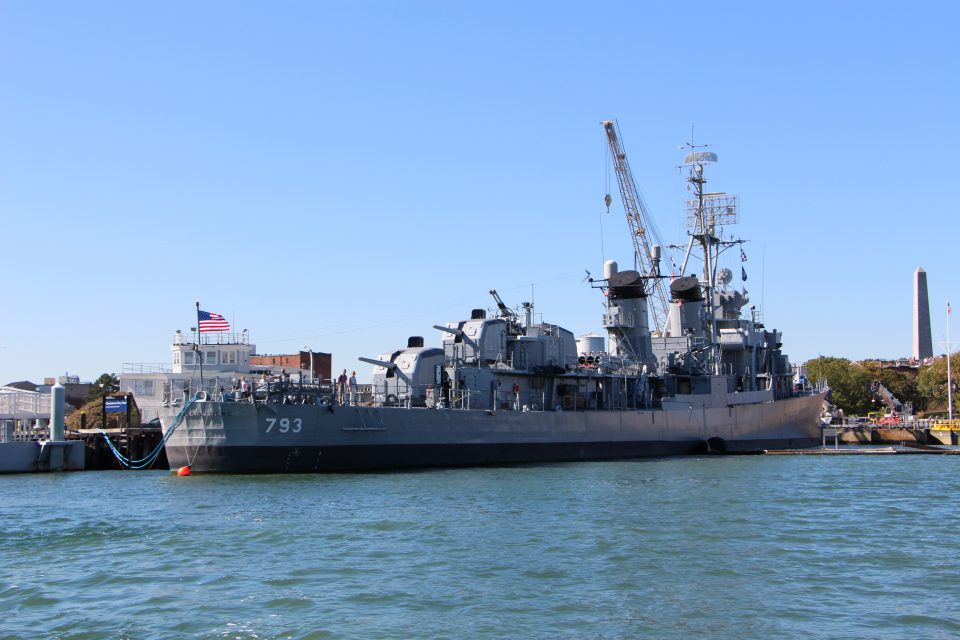
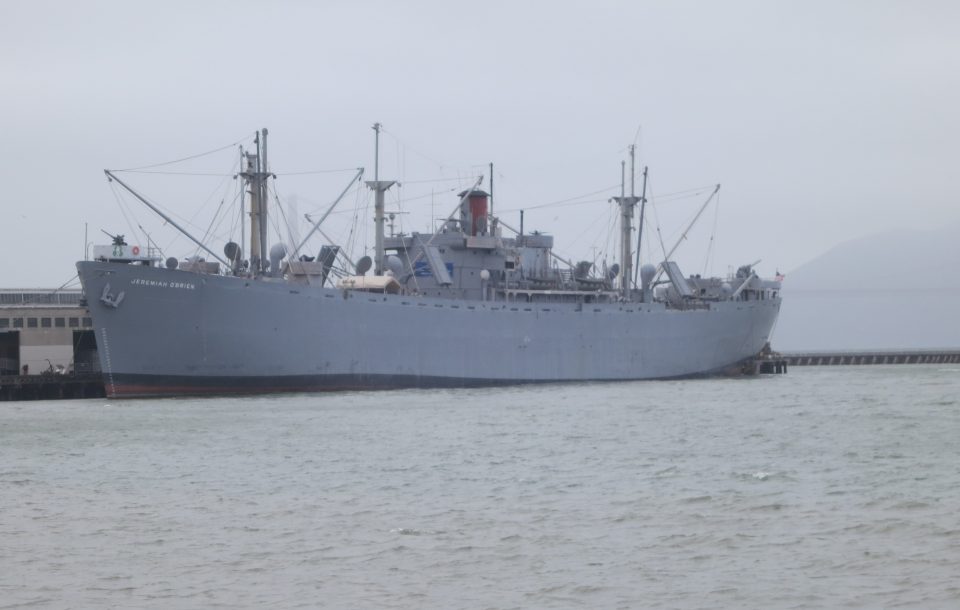
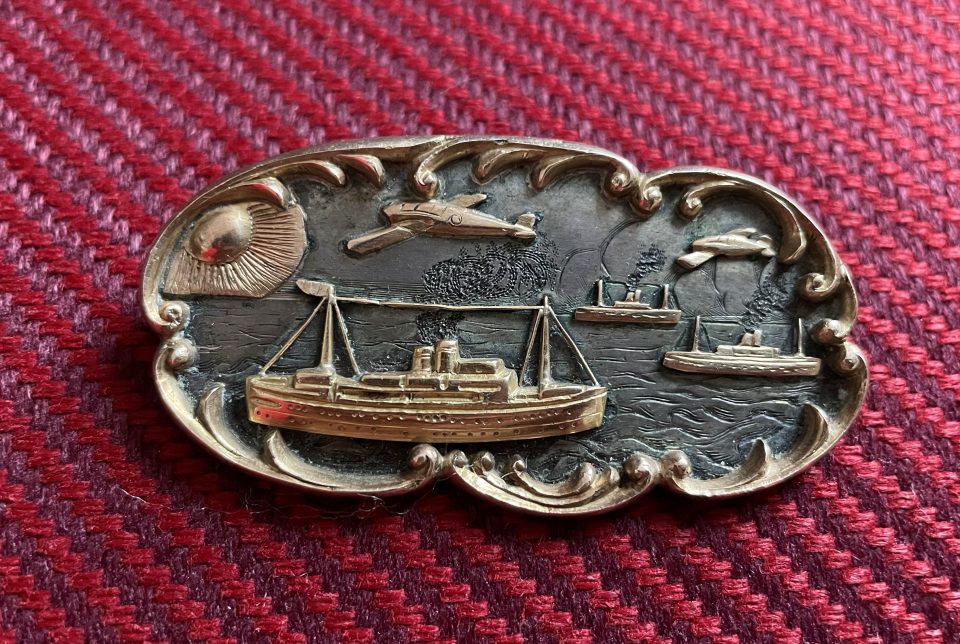
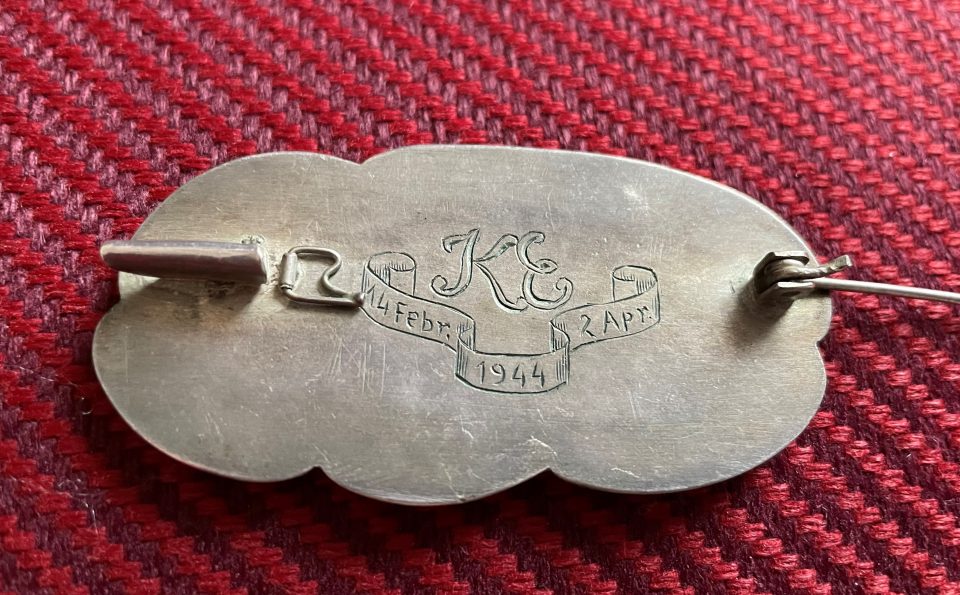
My great-aunt, Katharina (Käthe) Elzholz, a very tough and courageous woman, crossed the Atlantic alone on an Allied convoy during World War II in the winter of 1944 to join her husband, Karl Elzholz, in Bolivia. Käthe, a bank clerk, had fled the Nazi persecution of Jewish citizens in Vienna in November 1938 taking on a job as a cook in an English household. She married Karl Elzholz, who had fled to Bolivia and whom she knew in Vienna, on 11 August 1943 in London in a long-distance civil wedding ceremony. Due to intense fighting on the Atlantic, the “Battle of the Atlantic”, she could not risk the dangerous voyage to Bolivia until 14 February 1944. At her arrival on 2 April 1944, she was given this commemorative brooch by her husband (see above).
Käthe, born on 17 July 1901, was a widow after the early death of her husband Poldl Kluger. She had been forced to quit her job as a bank clerk due to the Nazi race laws introduced in Austria in March 1938 and had to work as a fashion model to earn her livelihood. She clearly saw the threat the racist NS ideology posed for those in Austria who were born Jews – she herself was not devout – and tried to flee the country as soon as possible and help her family members to do the same. She was the eldest of the four “Sobotka sisters”: Lola (my grandmother), Agi and Marianne (Mitzi). As the eldest sister Käthe felt responsible for their well-being as well as for that of their parents, Ignaz and Rudolfine (Ritschi) Sobotka. She took cooking lessons, learned English and eventually managed to get a work permit and a visa as a domestic servant in England (see article “Maid Servants in England”). Unfortunately, Käthe was not able to get her elderly parents out of Vienna and regrettably also her sister Mitzi together with her husband Karl could not procure visa for Ignaz and Ritschi to join them in Bolivia. They ended up in the concentration camp “KZ Theresienstadt”, but miraculously survived (see article: “The KZ Theresienstadt”).
All Käthe’s small savings were taken by the Nazis because Austrian Jews had to pay the “Reichsfluchtsteuer” (a tax levied on Jews who managed to leave the country) and they were not allowed to take any valuables abroad. Käthe was allowed to bring 2.10 pounds as “travel allowance” to England and she was denied any exemption limit and travel relief, as visible in her passport.
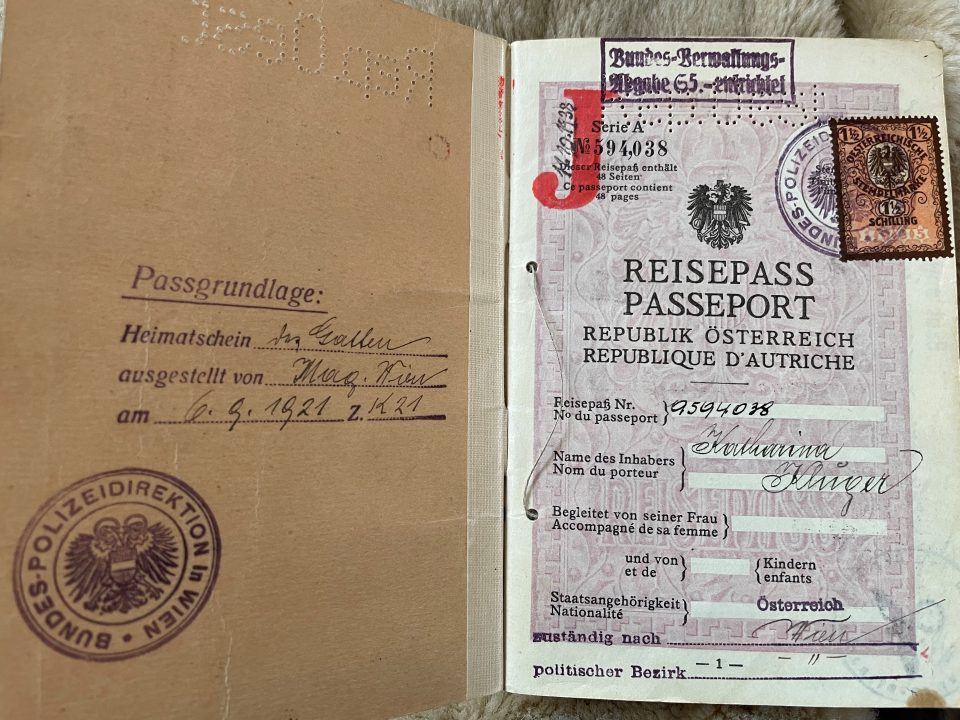
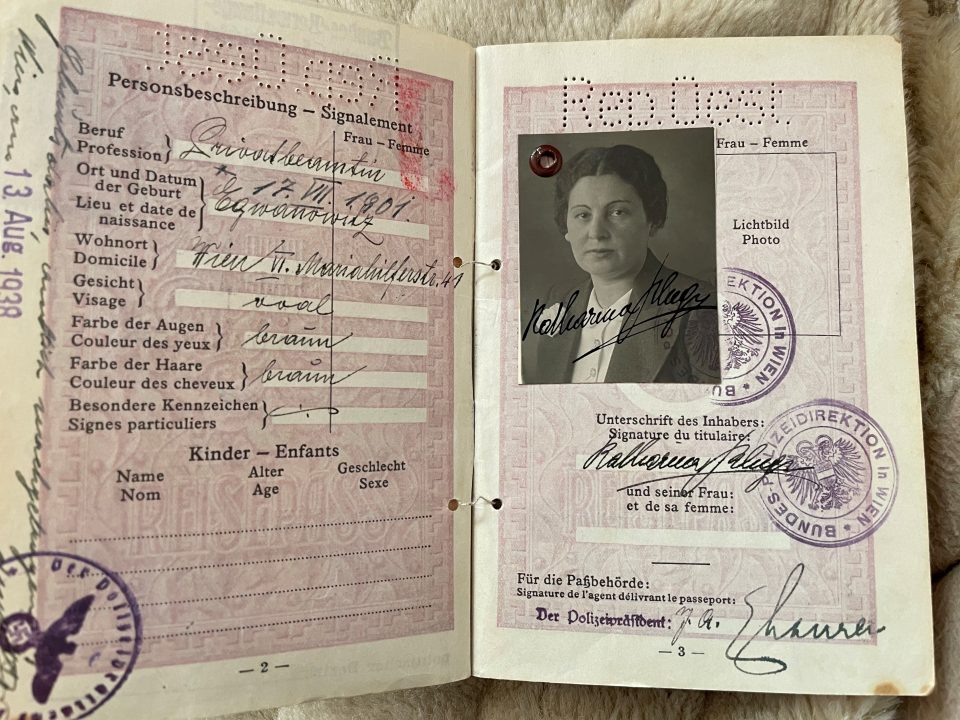

From England Käthe managed to get a work permit and a visa for her younger sister Agi Katz to work as a maid in the same household and to have Agi’s two-year-old twins, Susi and Josi, brought to England on a “Kindertransport” (see article “Kindertransports from Vienna to England”) to join their parents. My grandmother Lola was at that time considered “safe” in Vienna as she was married to non-Jewish Toni Kainz, my grandfather. Käthe’s youngest sister Mitzi fled with her husband, Karl Elzholz, to Bolivia in January 1939 (see article: “Viennese in Exile in Bolivia”.) Karl was nearly 20 years older than Mitzi. After their arrival in Bolivia Mitzi fell in love with a young German refugee, Bill (Wilhelm) Stern, and wanted to marry him. The couple decided to divorce and while Mitzi married Bill, Karl asked Käthe, his former wife’s elder sister, to marry him. They had known each other in Vienna as in-laws and were closer in age to each other. Karl was 11 years older than Käthe, so when they finally married on 11 August 1943, Käthe was 42 and living in England, 25 Warkworth Gardens, Isleworth, Middlesex, and Karl was 53 and living in Sucre, Bolivia, running a small shirt manufacturing business together with Mitzi and Bill.

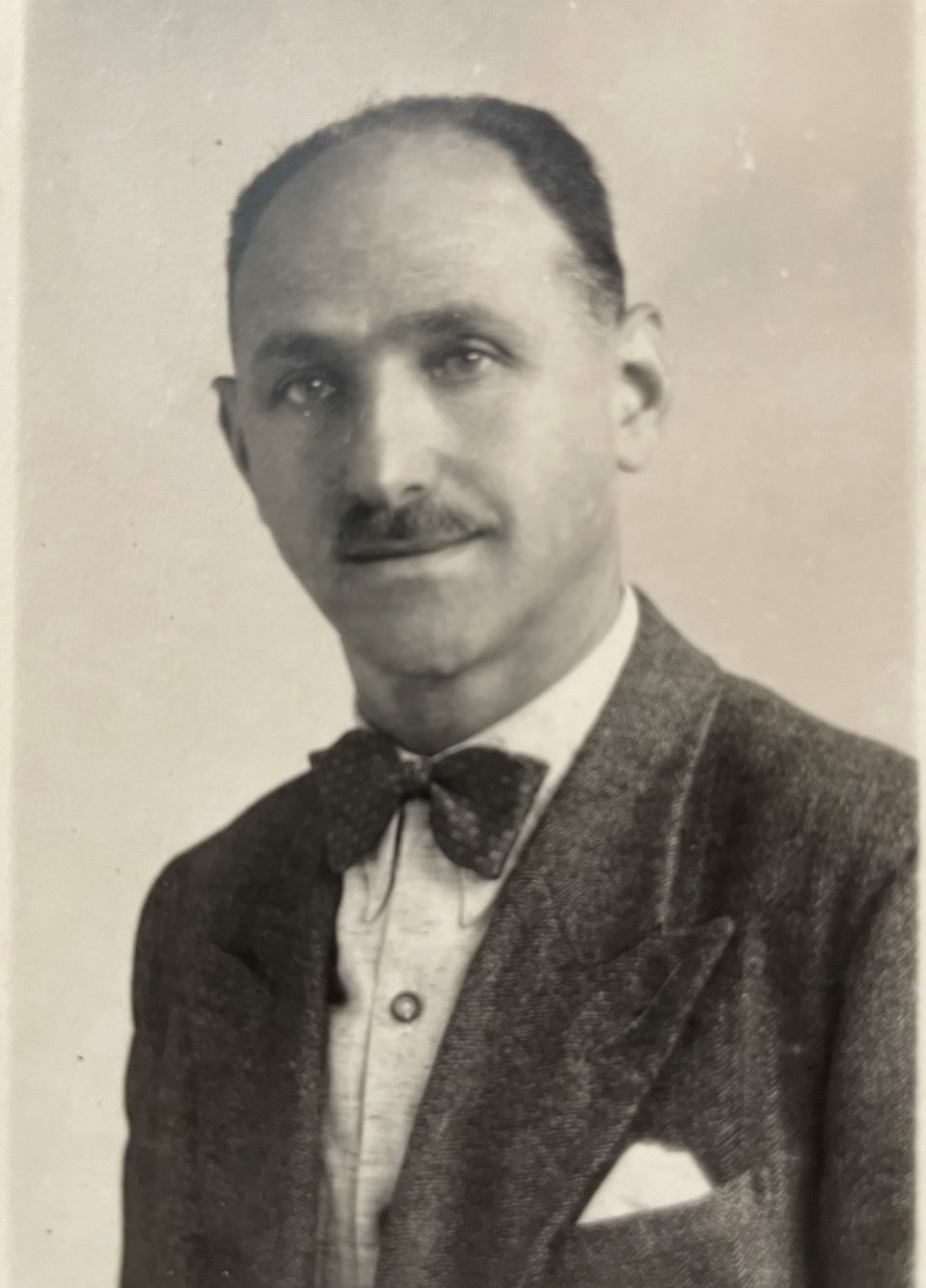
Below a copy of their marriage certificate can be seen: It was issued by the Bolivian ambassador in London. Karl Elzholz was represented in London by Norbert Katz, the husband of Agi and brother-in-law of Käthe and formerly also brother-in-law of Karl, when he was still married to Mitzi. So, they were all family and at that time Kathe, Agi, Norbert and the twins lived together in the flat in Isleworth. Two other refugees from Vienna, Irene Pollak and Fritzi Kappermann and their husbands, Austrian refugees in London, acted as witnesses to Käthe’s marriage in London.

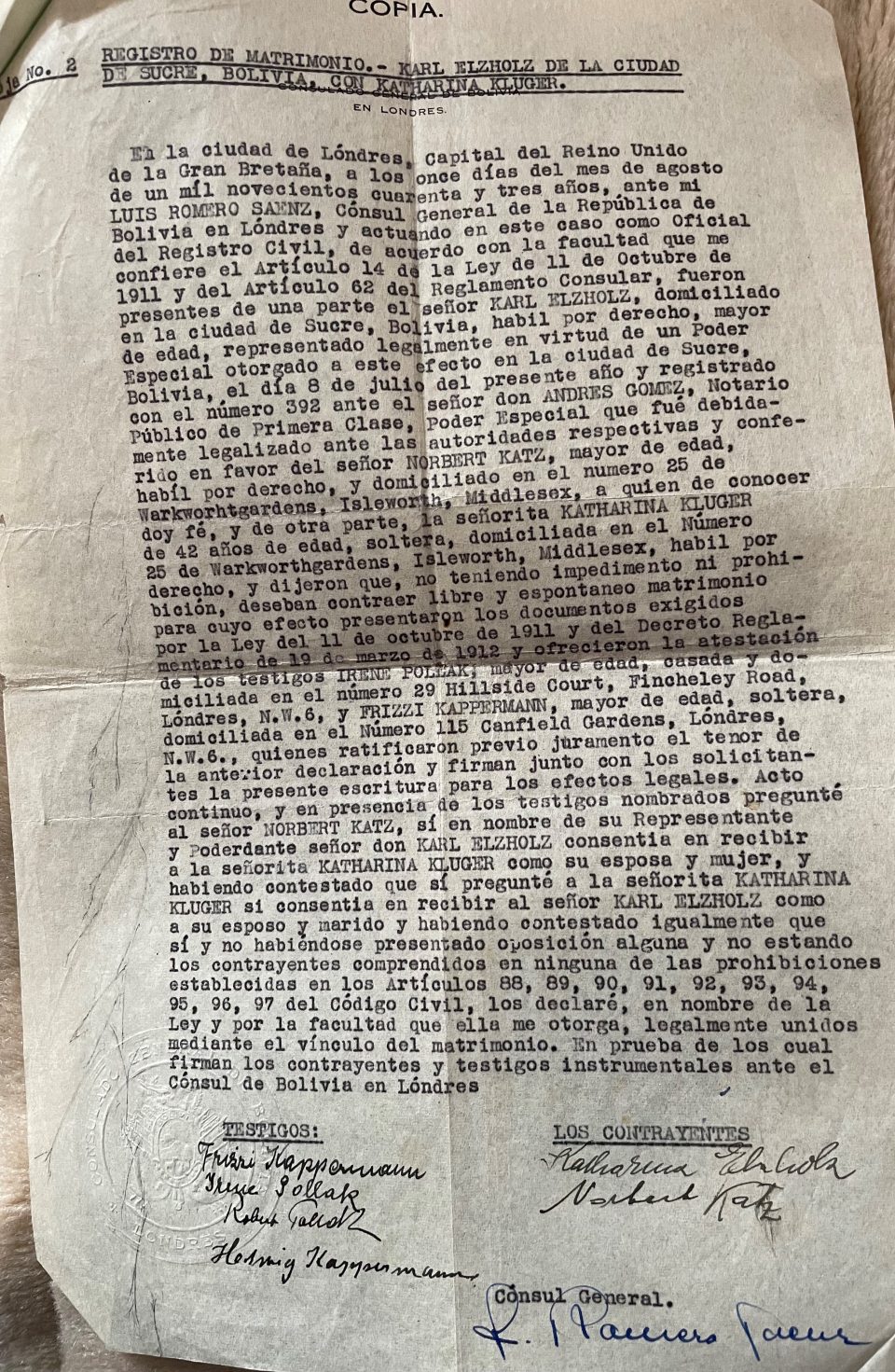
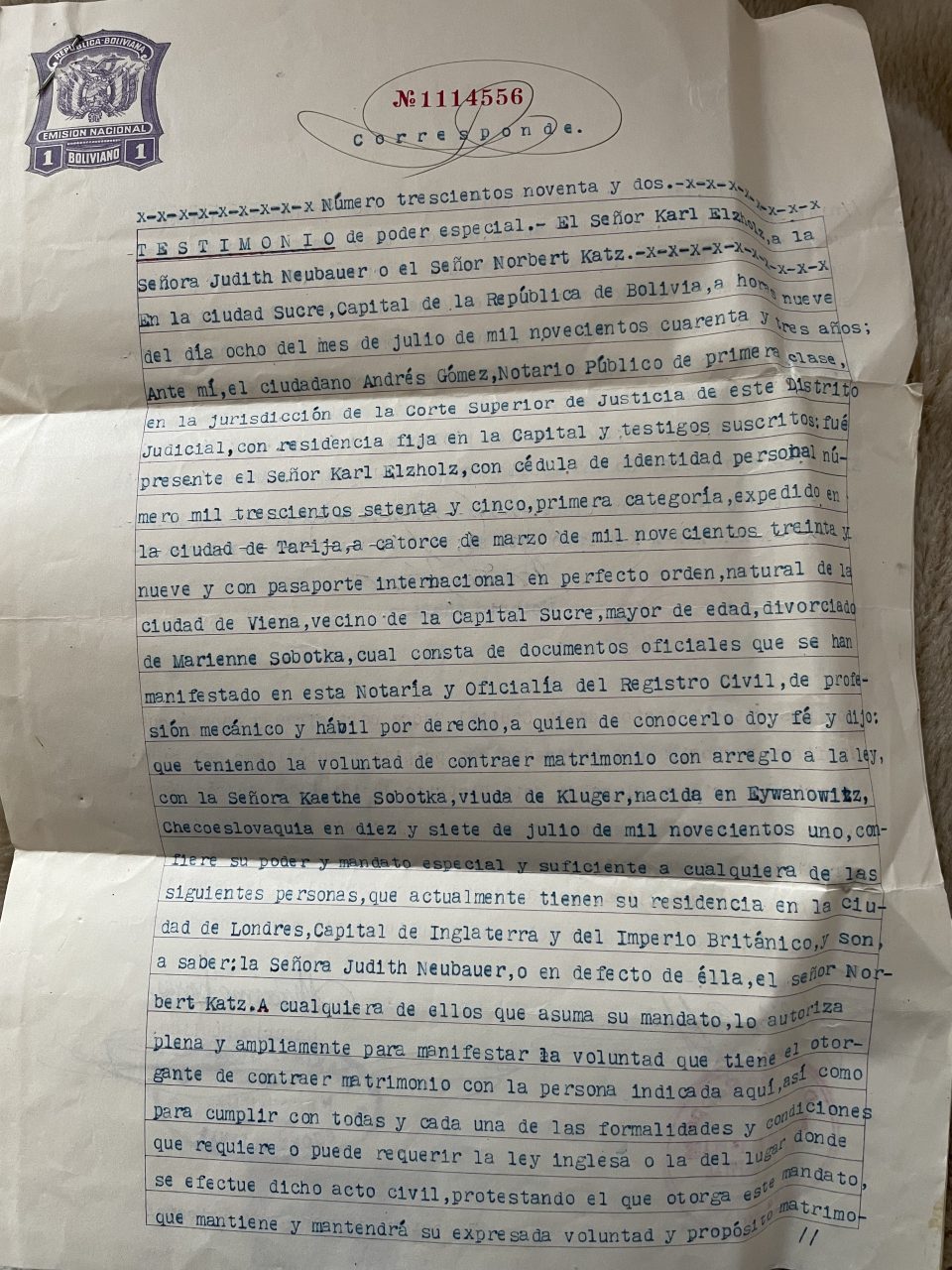

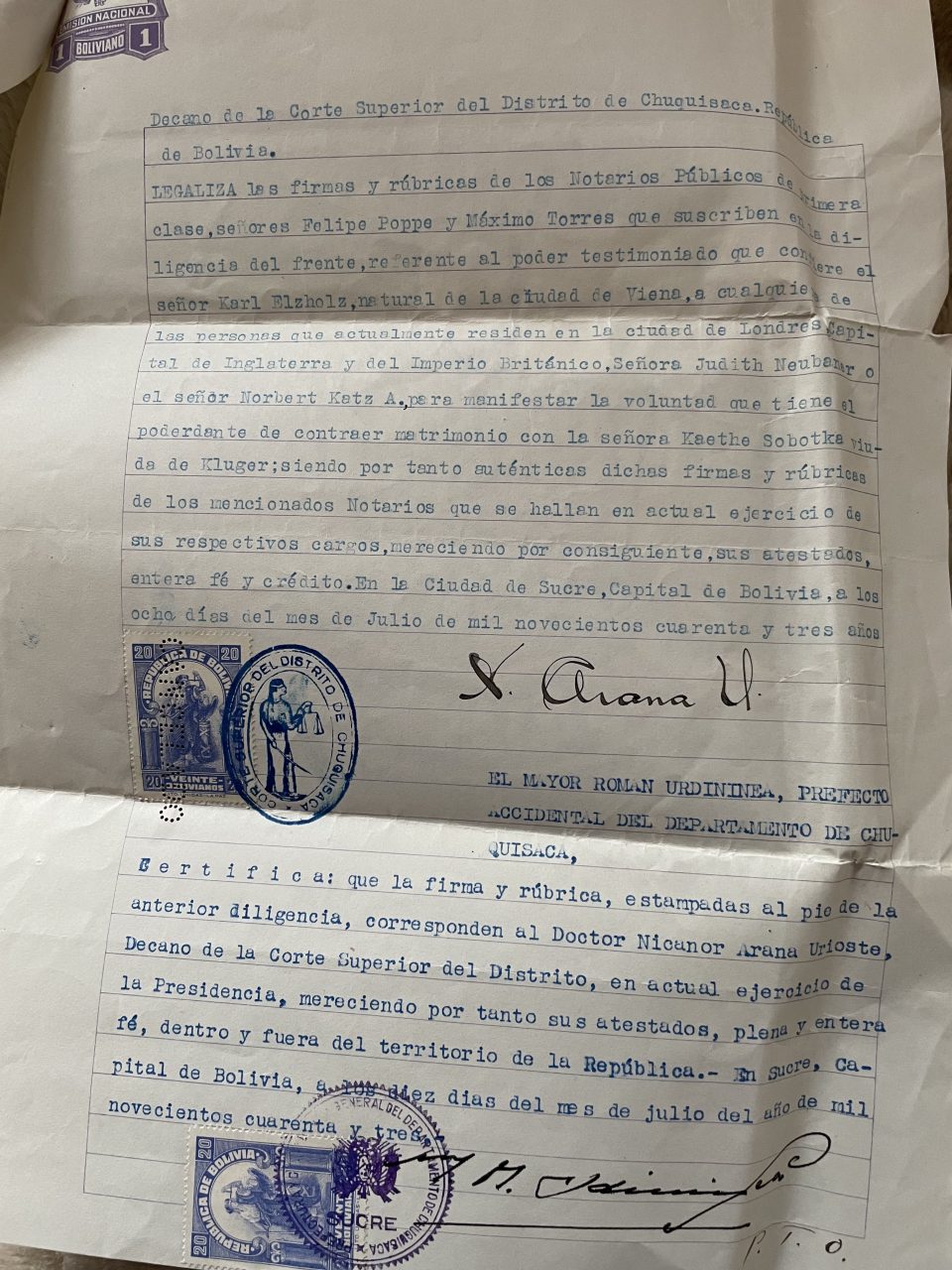

As soon as Karl had proposed to Käthe and they had decided that she would join him in Bolivia, she started to learn Spanish. For Käthe moving to Bolivia meant fleeing the war in Europe. During the war Käthe’s sister Lola, my grandmother, and her family, who had remained in Vienna, had no idea what was happening to their relatives in England and Bolivia and they were immensely surprised to hear about the divorce of Karl and Mitzi and the marriage of Karl and Käthe and Mitzi and Bill after the war. It can be assumed that Karl and Käthe both suffered from the loneliness and isolation typical of refugees in a foreign country, especially as they both lived in the same household with relatives who had their own families: Käthe with her sister Agi’s family and Karl with his former wife Mitzi and her new partner Bill. Although they were no longer young, they seemed to have yearned for a partner with whom they got on well. Käthe and Karl had been planning their marriage since 1942, which is documented by some photos Karl sent her to England from Bolivia. At the back of the photos Karl described where he lived, what Sucre and the shop they ran there looked like:
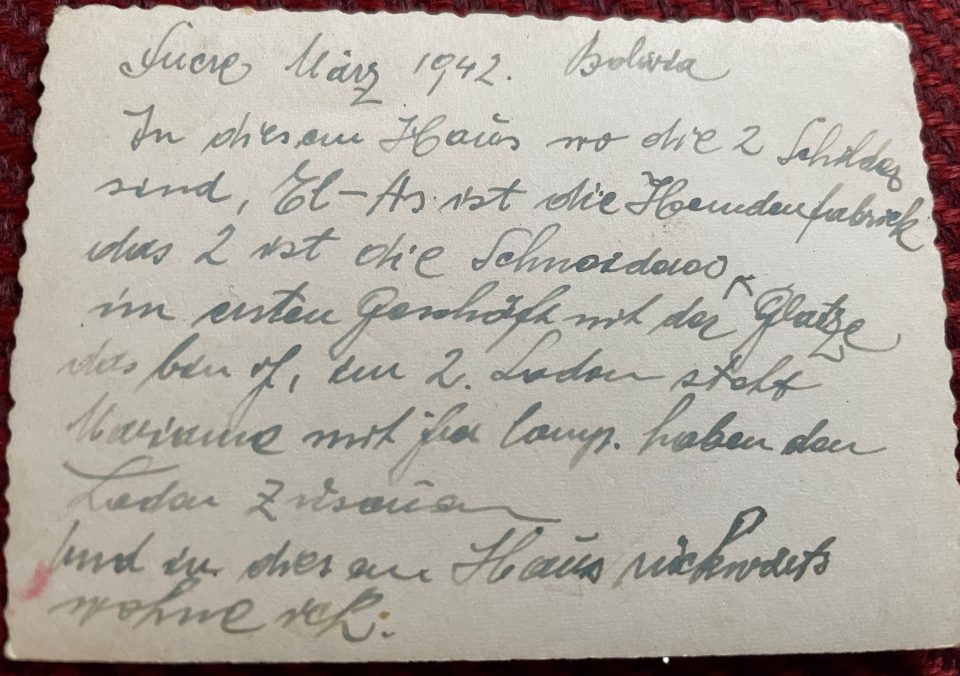
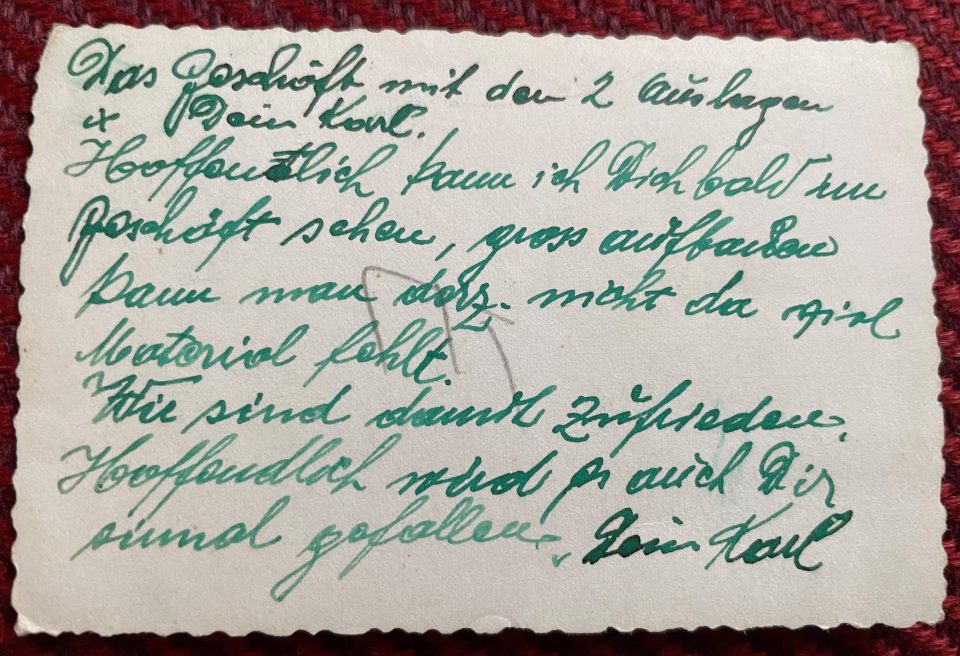
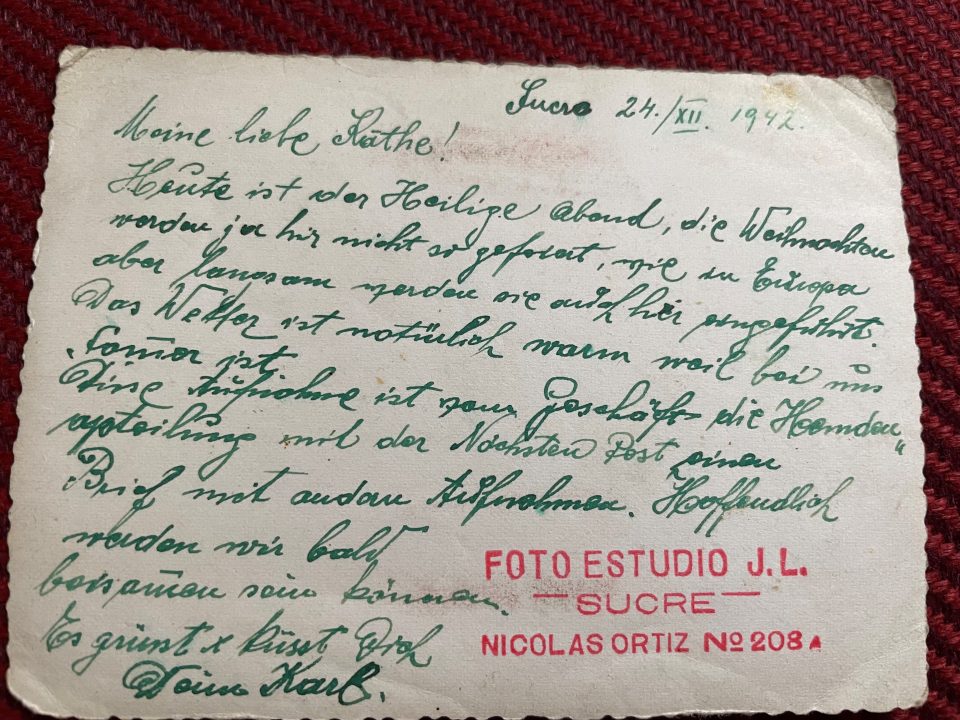

Käthe had endured the “Blitz”, the heavy German bombardment of London and its surroundings from September 1940 until May 1941, and the imminent threat of a Nazi invasion, which if successful, would have meant deportation to NS concentration camps and near certain death for her and her sister Agi Katz, her husband Norbert Katz, a famous Viennese footballer (see article: “Viennese Football”), and their young twins. In 1943 Käthe was waiting for an opportunity to get a place on one of the ships crossing the Atlantic Ocean in an Allied convoy to join her husband Karl in Bolivia. Yet for the time being the “Battle of the Atlantic”, which reached its peak in March 1943 with the highest losses of ships in Allied convoys due to German submarine – “U-boat”- attacks, made a crossing for her impossible and much too dangerous.
Käthe and Karl were finally reunited on 2 April 1944 after Käthe had undergone a long journey of 48 days from England by boat to Argentina and then on to Sucre in Bolivia.
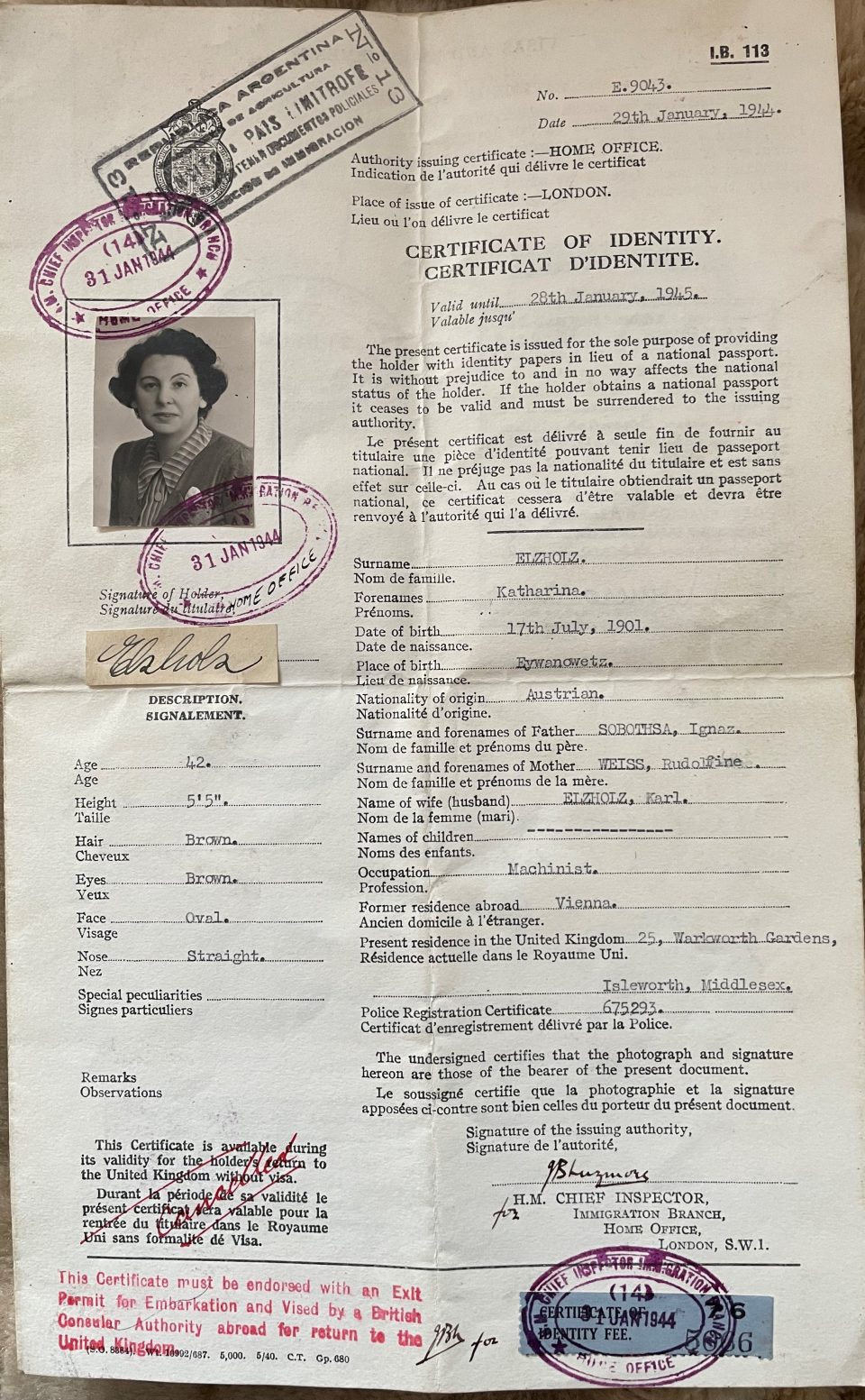
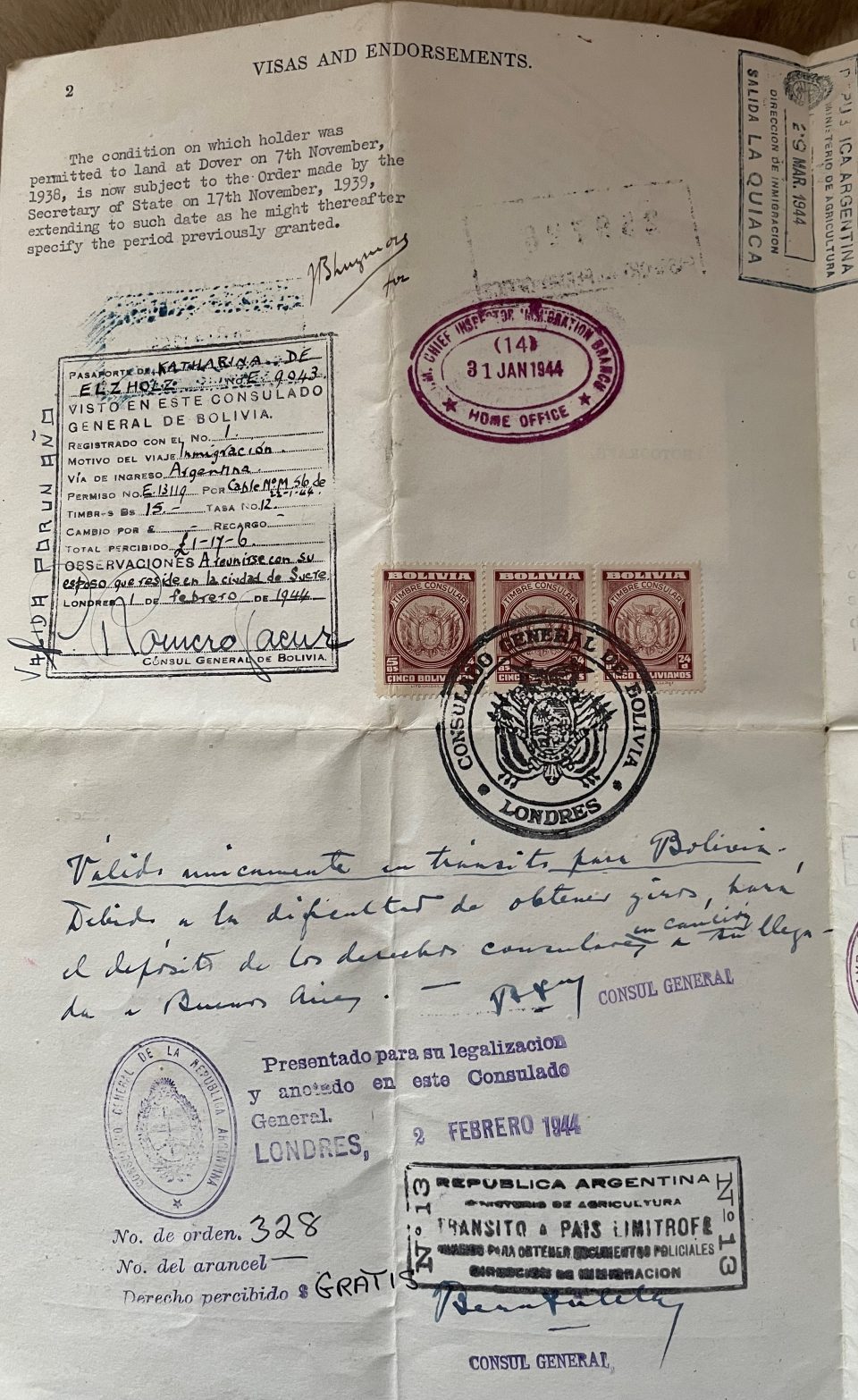

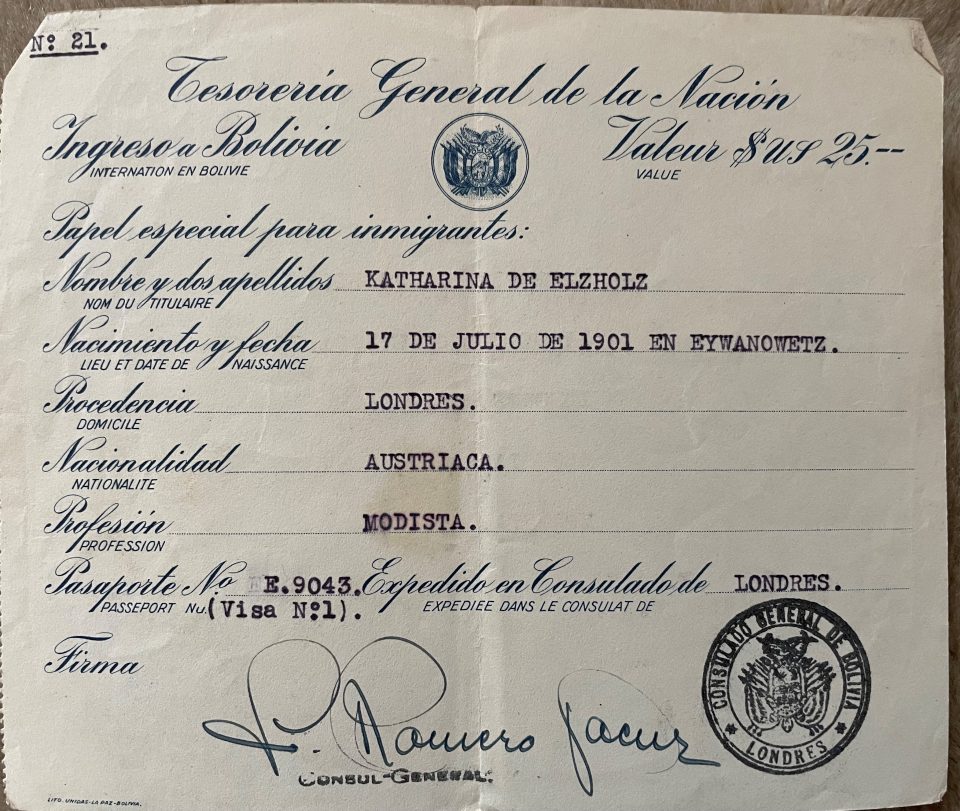
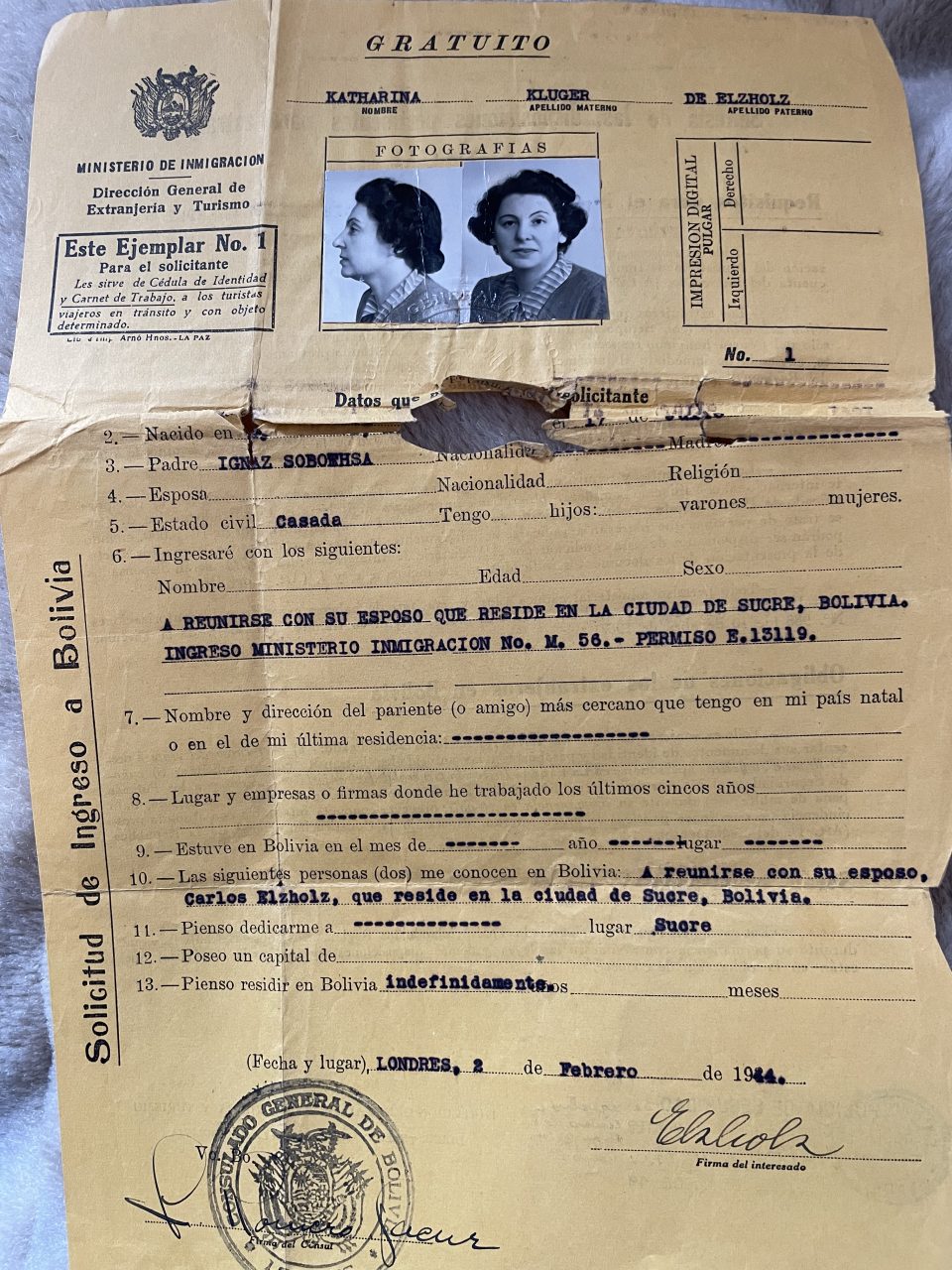
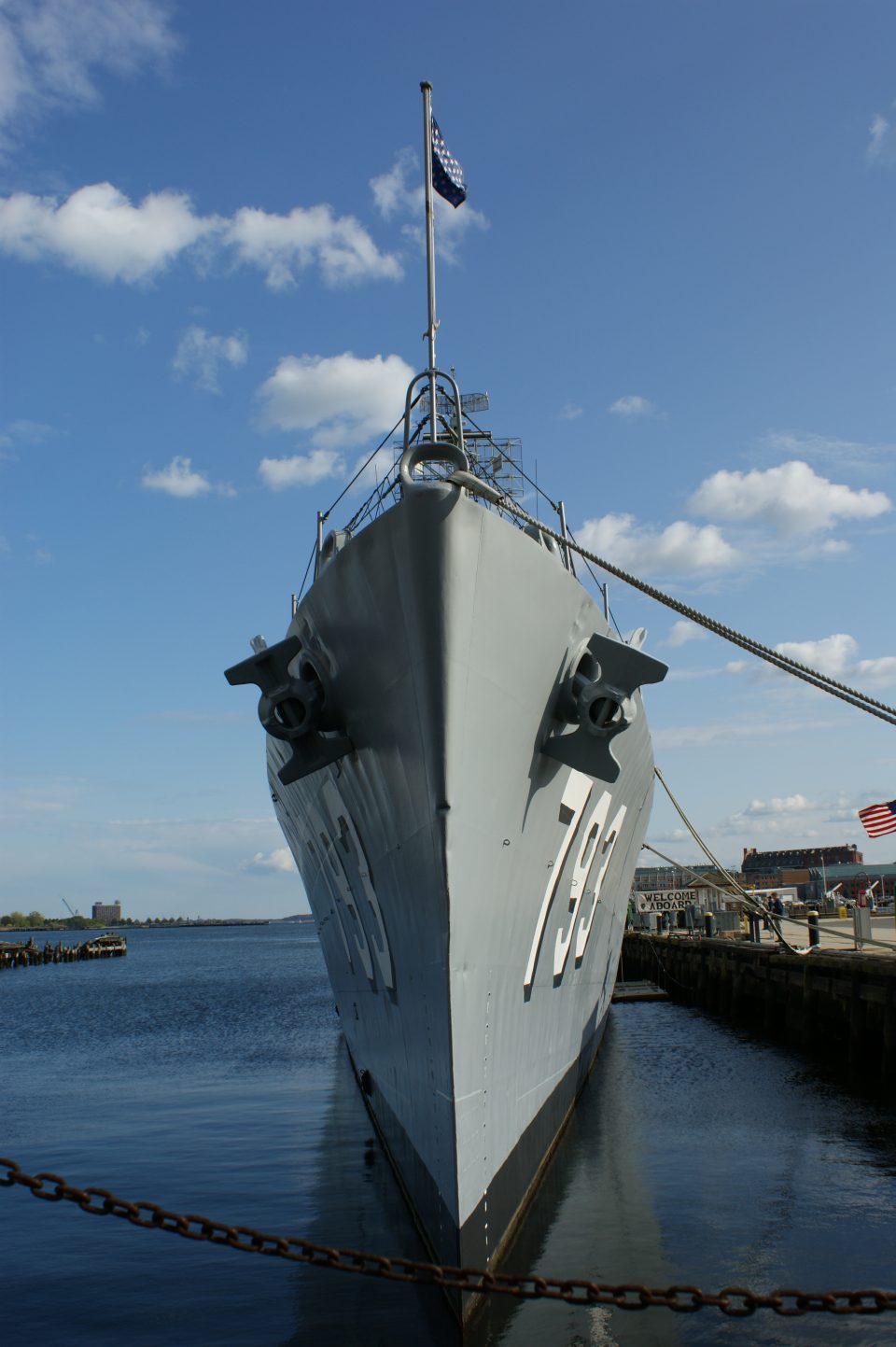

The problem for Käthe was to get permission to purchase a place on an Allied convoy crossing the Atlantic Ocean amid World War II. Convoys, groups of merchant ships and liners sailing under the protection of an armed escort, had been organised by the British since the Napoleonic wars, but became crucial in the First World War, when the Germans waged “unrestricted” submarine warfare against Allied shipping routes. If the US had not come to Britain’s rescue in 1917 the German attacks would have turned out calamitous for the British. At the beginning of World War I the British Admiralty had not given due weight to the threat of the then new German maritime weapon, the submarine or “U-boat”. They regarded the convoy system as outmoded because coal-fired ships travelling together in large numbers would form a prominent target for the enemy. Furthermore, the military authorities were reluctant to use warships defensively as convoy escorts, but rather use them in open battle confronting the enemy. What’s more, the British shipowners and speculative investors opposed the concept of leading their ships through the war zone under the protection of the Royal Navy. They preferred that their ships would be sailing independently because they were faster as no stragglers in a convoy slowed down their passage. Furthermore, no logjams were created in the respective harbours of arrival, which was unavoidable if thirty or more ships arrived simultaneously at a destination. Above all, the shipowners and speculators profited as handsomely when their ships were sunk by the enemy as when their cargoes reached their destinations safely. They not only benefitted from huge insurance pay-outs in case of the loss of a vessel, but at the same time from the growing demand for ships to replace the losses. It is no exaggeration to say that the more ships were sunk by the Germans, the richer the British investors became. For all these reasons, the British were slow to react to the growing threat of an ever-larger German U-boat fleet. Yet the Germans no longer abided by the international “Prize Rules”, which stated that no merchant vessel could be sunk by a submarine until it had been searched and its crew provided with a place of safety. Following the unilateral repudiation of the “Prize Rules” by the Germans, the number of Allied sinkings rose sharply. The deployment of US warships on escort duty in 1917 transformed the course of World War I at sea. The US saved Britain from being starved into surrender and proved the importance of the convoy system in protecting the Allied lifeline across the Atlantic from U-boat attacks, which the British Admiralty had resisted for so long.
During the interwar years, Britain lobbied unsuccessfully for an outlawing of submarines; they only managed to get international support for a reform of the “Prize Rules”; a quite ambiguously formulated treaty, the “London Naval Treaty” of 1930. In 1936 more than 30 nations added their signatures to the “Second Naval Treaty”, including Germany. Again, the British Admiralty was convinced that the Germans’ unrestricted submarine warfare during World War I had proved so disastrous for them that they would not make the same mistake again. Royal Naval officers neglected to analyse data that showed that escorted convoys supported by aircraft had saved the nation in 1917 from collapse. The Royal Navy was proud of its warships and cruisers and did not want to “waste” them in a mundane task of escorting merchant ships – it was a far too defensive concept for them. The sinking of the “Athenia”, a passenger liner, within hours of Britain’s declaration of war in September 1939 shattered the British Admiralty’s concept. The British Prime Minister Churchill as First Sea Lord was informed on 4 September that the Germans had sixty U-boats and that a hundred more would be in operation by early 1940. On 6 September the Admiralty made the formal decision to re-introduce the convoy system, but the Royal Navy was alarmingly short of escort vessels and those available were mostly unsuitable in size and type and their crews were untrained. Air support for the convoys by the RAF (Royal Air Force) was virtually inexistant. The limited supply of fighters and bombers was not to be used for such defensive tasks as safeguarding British maritime supply lines. But Hitler’s “Third Reich” was far from ready to confront the US on the Atlantic Ocean, too, which is documented by Hitler’s anger about the sinking of the “Athenia” and the Germans’ breach of the “London Naval Treaty” of 1936. Hitler had a continental war in mind; he wanted to subjugate Europe and then to invade Russia, which would require a close cooperation of the German army and the air force. The German navy would have to take third place. So, both Germany and Britain were ill-prepared and ill-equipped for the “Battle of the Atlantic”. Yet in November 1939 unrestricted U-boat warfare was the German commander Dönitz’ official, though still unstated, policy. Although individual merchant ships sailing alone were now attacked by German submarines, the targets that really mattered for Dönitz in terms of tonnage of freight were the convoys. Locating and destroying convoys by means of concentrated attacks of U-boats, so-called “wolf packs” of eight up to twenty U-boats, presented the opportunity for the “Third Reich” to strangle Britain’s Atlantic lifeline.
The drama for Britain began in December 1939, when the German strategy was defined as disrupting and destroying all enemy shipping in the North and South Atlantic. The aim was sinking as many Allied merchant ships as could be found without putting the German navy at risk. As Britain lacked enough naval escorts to protect every merchant convoy along the many trans-continental shipping routes, “evasive routing” was virtually the only way to avoid German U-boats. Evasive routing only worked if a merchant ship under attack managed to radio its position before it was sunk. The other ships in the region, which received the signal were then ordered to alter course and try to avoid the attackers. Eight “hunting groups” were deployed by the British to track down and sink the attackers. Nevertheless, these hunting groups were not powerful enough to safeguard Allied convoys. In 1940 the shortage of escort warships to protect the major shipping routes on which Britain depended for its survival reached critical proportions. The U-boats encountered a large number of merchant ships sailing independently and therefore unprotected, while Allied convoys were weakly safeguarded as well and not at all accompanied by aircraft. The Royal Navy had to protect the British shorelines from a German invasion and at the same time it had to protect the vital Atlantic convoys. In a nutshell, the Royal Navy had to defeat invasion, the German “Operation Sealion”, and avoid starvation in Britain. In this situation the US President Roosevelt came under pressure because Churchill told him that Britain’s survival was at stake and that it had to be in the strategic interest of the US to assist the UK. Finally, US scrap-value destroyers were on their way across the Atlantic, a demonstration of the US commitment to the British cause. Although Roosevelt was as anxious as Hitler to avoid a shooting war in the Atlantic, the conflict escalated on the Atlantic shipping routes. The US extended their Security Zone there, but this did not deter the wolf packs, which could operate from French harbours after the German invasion of France in June 1940. The German U-boats could now more easily launch attacks in the so-called “Black Hole” or “Atlantic Gap”, which was the most exposed part of the lifeline between Britain and America. It comprised approximately 300 miles from east to west and some 600 miles from north to south. It was an area of 180,000 square miles of ocean, which were beyond the reach of the Royal Air Force before the US joined in the war. Unfortunately, all British aircraft carriers were deployed elsewhere. The Atlantic convoys were thus without aerial protection (“Air gap”) in this vast maritime region. The wolf packs were hunting these waters in surging numbers without risk of being attacked by Allied planes. The British suffered an acute shortage of vessels and trained sailors as well, so eventually the Royal Canadian Navy tried to assist in the protection of the sea routes in the Atlantic Ocean.

So, in the first years of World War II the crossing of the Atlantic on merchant ships, sailing independently or in convoys, was extremely dangerous and should not be undertaken by civilians. Nevertheless, British passenger lists reveal that service personnel, war brides and evacuated children undertook this dangerous passage. Apart from the submarine threat the passengers had to brave the rough seas of the North Atlantic. Yet at the time of the German “Blitz”, the “Battle of Britain”, the authorities decided to evacuate thousands of children to Commonwealth states, Canada, Australia, New Zealand and South Africa. Between July and September 1940, the “Children’s Overseas Reception Board”, which was set up by the British government, evacuated 2,664 children from Britain to protect them from German bombardments and a possible invasion. These “sea-evacuees” were to be temporarily re-located during the war and were transported on merchant ships and liners in convoys. Two of the ships, the SS Volendam and the SS City of Benares were torpedoed by German U-boats within a couple of weeks. The 320 children on board the SS Volendam were rescued, but of those on board the SS City of Benares 134 passengers and 121 crew members were lost on 18 September 1940. Of the 90 children on board 77 drowned, when the ship sank. After this catastrophe the whole programme of “sea-evacuees” was scrapped as the Admiralty was held responsible. The Germans sarcastically justified themselves saying that the British were not supposed to put children on convoys and by that make them victims of war.
Civilian passengers were transported on freighters or on liners which had been turned into troop carrying ships. The formerly luxurious accommodation was converted to carry many more passengers. Civilians had to have special governmental permissions to travel on a convoy; mostly government officials and industrialists received them. On 14 March 1941, for example, the Dutch freighter MV Bodegraven sailed from Newport to New York. The passenger lists show that there were 40 male government officials and four female “models” on board. It can be assumed that these people were male and female British service personnel connected to the war effort, because just a few days before the ship’s departure US President Roosevelt had signed the Lend-Lease Agreement with Britain, by which the US provided Britain with war planes and war ships. In exchange the US was allowed to use British air bases in the North Atlantic. Apart from troop movements, convoys were transporting the wives and other dependents of servicemen across the Atlantic Ocean. The Canadian government, for instance, reported that from 1942 until 1948 64,451 servicemen’s dependents arrived in Canada on convoys, including children born to Canadian-British couples in the UK during the war.
In the summer of 1941, the German U-boat fleet had grown to sixty-five operational ones, but a significant number of Allied convoys seemed to have been diverted from the expected route across the Atlantic as if avoiding the German wolf packs. The German Admiral Dönitz was surprised. His headquarters in Kerneval, which planned and directed the movements of the submarine fleet, was looking for an explanation. On the side of the British, their staff in their headquarter in Derby House had managed to charter as precisely as possible the latest positions of the U-boat wolf packs and the Allied transatlantic convoys. Based on these data Admiral Noble had to plan the safest routes of the convoys. Unfortunately, the radio technology of the time was still inaccurate and an error of one decimal point in the navigator’s fix from an aircraft or submarine, maybe magnified by the transfer of these data to the chart, could have deadly consequences for many people. The Germans knew that the British used land-based radio direction finders (D/F) to locate radio transmissions between U-boat commanders and headquarters, but they were not too worried because as the signals became more distant, the more they were subject to error. Yet by the summer of 1941 the chain of D/F had extended via Newfoundland, Greenland, and Iceland to cover the whole North Atlantic. Consequently, the British were able to fix the position of a German U-boat signal in most of those waters. As a result, the U-boat commanders were ordered to transmit messages only when it was essential and to be extremely brief. But the main reason why the convoys managed to dodge the wolf packs was another one. In March 1941 the British captured a collection of documents on a fish trawler near the Norwegian Lofoten Islands, which contained the settings for the use of a German cipher machine in the area around Britain, called Enigma.
The original Enigma machine had been developed by a German engineer who wanted to sell a secure communications system to commercial companies in the 1920s. It ended up in the Polish government’s Cipher Bureau, where a team of engineers managed to reconstruct the machine, which the German military was using, and to decrypt secret German military traffic just before the outbreak of World War II. When the Nazis invaded Poland in September 1939, Polish officials passed their knowledge on to the British code-breakers at Bletchley Park, the secret headquarters of the Government Code & Cypher School (GC&CS). Alan Tuning and Harry Hinsley at Bletchley Park contributed considerably to breaking the Enigma code and by that helped safeguard the lives of thousands of people on Atlantic convoys. Even though more convoys escaped the wolf packs, the German crypto-analysts would not even consider the fact that Enigma could be broken. Ultra, the code word for breaking Enigma, was kept an inviolable secret, even after the war. But it must be mentioned that both sides were reading a large proportion of the enemy’s signals with respect to Atlantic convoys. As the Germans changed their Enigma settings, also the British Admiralty regularly changed the Naval Codes and in the same way as Bletchley Park continued to break Enigma codes, the German B-Dienst (“Beobachtungsdienst” – communications service of the German Navy) invariably broke the Allied codes within weeks. Bletchley Park and B-Dienst had rewritten the rules of the war at sea, but the Battle of the Atlantic was still going on, culminating in March 1943. Unfortunately, money was saved by not providing merchant ships with a safe code system, which made it possible for the Germans to locate merchant ships easily. This cost the British in loss of ships, cargo and most of all human lives, hundreds of times the money saved in not properly equipping merchant vessels.
Allied escorts were still unable to protect Atlantic convoys efficiently due to a combination of confusion, inexperience, and incompetence. Although naval commanders were given some training in the basic principles of convoy protection, they had no chance to plan and rehearse the operations of counter-submarine warfare with their crews before action. The sailors, most of whom were conscripts hurriedly pressed into military service, had next to no special training. Only some of the escort vessels were equipped with functioning radio direction finders and they were often unable to hunt down the U-boats attacking the convoys in a forceful counter-attack. Lack of equipment and training abounded and the expansion of the escort fleet came late. As the Admiralty had failed to prepare guidelines for the protection of the Atlantic convoys, decisions had to be made by the individual commanders of escorts on the spur of the moment, which left the commanders at a crass disadvantage in the face of coordinated U-boat attacks. Furthermore, ships and planes operating in tandem would have formed a powerful shield for a convoy. A merchant ship thus protected was much more likely to arrive intact together with its cargo and passengers. Efficient aircraft would make it impossible for the U-boats to attack a convoy without risking being sunk. But the RAF lacked war planes for safeguarding convoys because they were needed to protect Britain from German assaults. Eventually, a rudimentary convoy system had been introduced along some parts of the American coast, but the proportion of ships protected was small and not well organised. Within one month for example, thirty-three merchant ships sailing independently on the US Atlantic coast were sunk by German submarines, whereby only four were lost under escort. Similarly, thirteen independent merchant ships were sunk in the Gulf of Mexico and only one in a convoy.
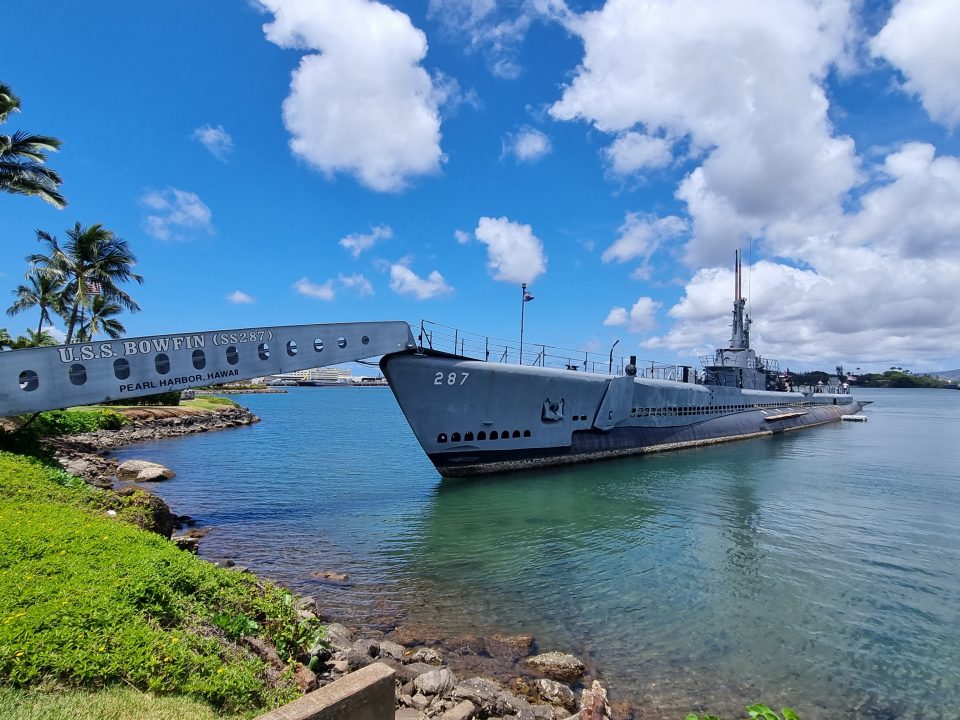
After the bombing of Pearl Harbour by the Japanese on 7 December 1941 the US became fully involved in World War II on the side of the Allies, declaring war on Japan, Germany, and Italy. This was a great relief for the British and in the long run meant a better protection for the Atlantic convoys. The gradual increase in numbers of medium-range bombers and long-range aircraft, namely the B-17 “Flying Fortress”, provided air cover to the convoys from bases in Greenland, Iceland, and Northern Ireland, by which the area of the “Black Hole” killing ground had been contracted. But it still left an area of around 300 by 300 miles for Atlantic convoys with no air cover at all. There were not enough “VLR Liberators” of the Royal Air Force available to Coastal Command to make an impact and by the last quarter of 1942 the Germans seemed to be winning the” tonnage war” (tonnage of freight sunk) in the Atlantic. The US command preferred to use their long-range bombers in offensive attacks on Germany rather than on defensive operations in the Atlantic Ocean, although the tragedy of dramatic shipping losses on the Atlantic routes was already unfolding. Data were available which demonstrated that a force of 200 long-range and very-long-range bombers would make a decisive contribution to the “Battle of the Atlantic” and bombers would be far better deployed protecting convoys than bombing Germany. The ultimate responsibility for this tragic error of judgment, which cost enormous losses of ships, cargo, and human lives in March 1943 with, for example, the German attacks on convoys SC.122 and HX.229, rests with the Western leaders Roosevelt and Churchill and their advisers. They did not understand that the deployment of bombers in sufficient numbers to subvert the submarine threat in the North Atlantic was as offensive as the bombing of Germany. As a result, the Germans were celebrating their successes in eliminating Allied convoys. On 19 March 1943 the U-boat headquarters reported the sinking of 32 vessels of 136,000 tons and one destroyer in a single convoy attack. The Germans never came so near to cutting off communications between Britain and the US as in the first twenty days of March 1943.
By the spring of 1943 the Allies had developed a 10-centimetre-wavelength radar which changed the war at sea. It was more accurate and could identify a U-boat from twelve miles away and keep it in focus until the pilot was close enough to unleash a cache of bombs or depth charges. This new system constituted a new threat to U-boats which had no answer to it so far. Furthermore, so-called “support groups” were formed with destroyers, whose task was the hunting down of U-boat patrols threatening the convoys. They were to operate in a planned and coordinated manner not only with convoy escorts, but also with VLR bombers. Unfortunately, the bombers were late to arrive, which caused the disaster. It was clear that eighty bombers were necessary to cover the Atlantic Gap.
Finally, in the spring of 1943 arresting the U-boat onslaught was given priority by the US Air Force as well. Together with releasing more of the 10-centimetre radar sets the number of aircraft allocated to the Bay of Biscay was doubled, which raised the total number of planes available to patrol the already narrowed “Black Hole” to 150. This decisively tipped the balance in the “Battle of the Atlantic” in favour of the Allies for the first time. Dönitz’ answer was to order all U-boats to be armed with heavy anti-aircraft guns and to instruct the crews to stay on the surface and fight it out. Some of the German crews obeyed the orders in a suicidal manner. Consequently, the Atlantic was the last front where the “Third Reich” was still on the offensive. May 1943 was the crucial phase in the “Battle of the Atlantic”. Finally and belatedly, the VLR bombers equipped with 10-centimetre radar had arrived and effectively closed the Atlantic Gap. This had an instantaneous and dramatic effect on the safety of the Allied Atlantic convoys. VLR Liberators, escort vessels with short-range bombers now accompanied most convoys through the most dangerous parts of the voyage. Many destroyers, frigates and corvettes were equipped with the latest Huff-Duff technology, the new radar systems, and new bow-mounted weapons, the “Hedgehog”, which could sink a retreating U-boat above and below waters. Above all, crews were now trained much better by battle-hardened commanders and the support groups were able to hunt down any attacking U-boat. Escorts were succeeding in sinking more and more U-boats, although the German shipyards were turning out ever more submarines. Already for April 1943 the shipping losses of the Allies had been reduced by 50 percent. The Western commanders were sufficiently shocked by the losses of March 1943 to provide enough aircraft and ships to ensure that the Atlantic lifeline could no longer be severed.
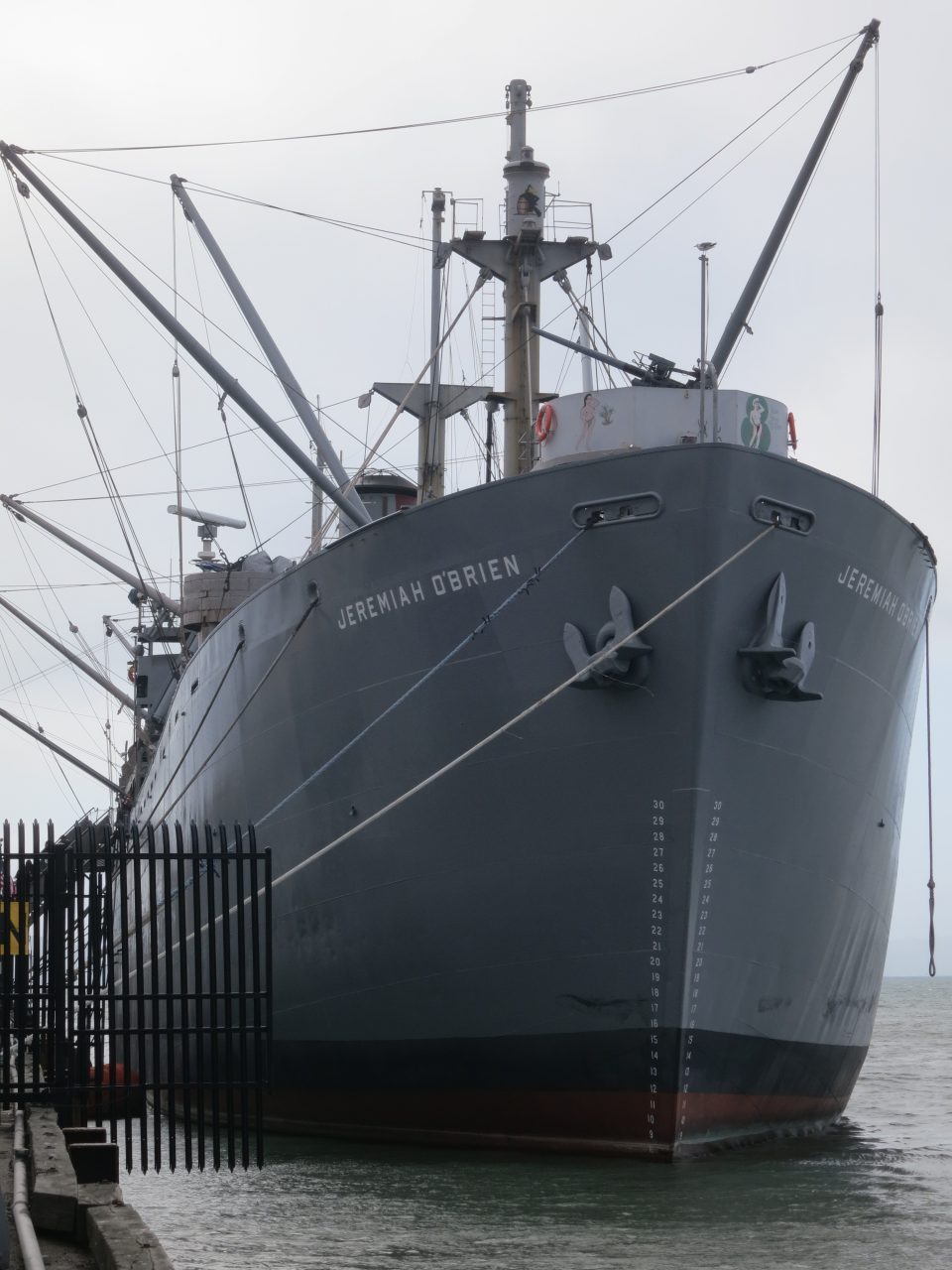
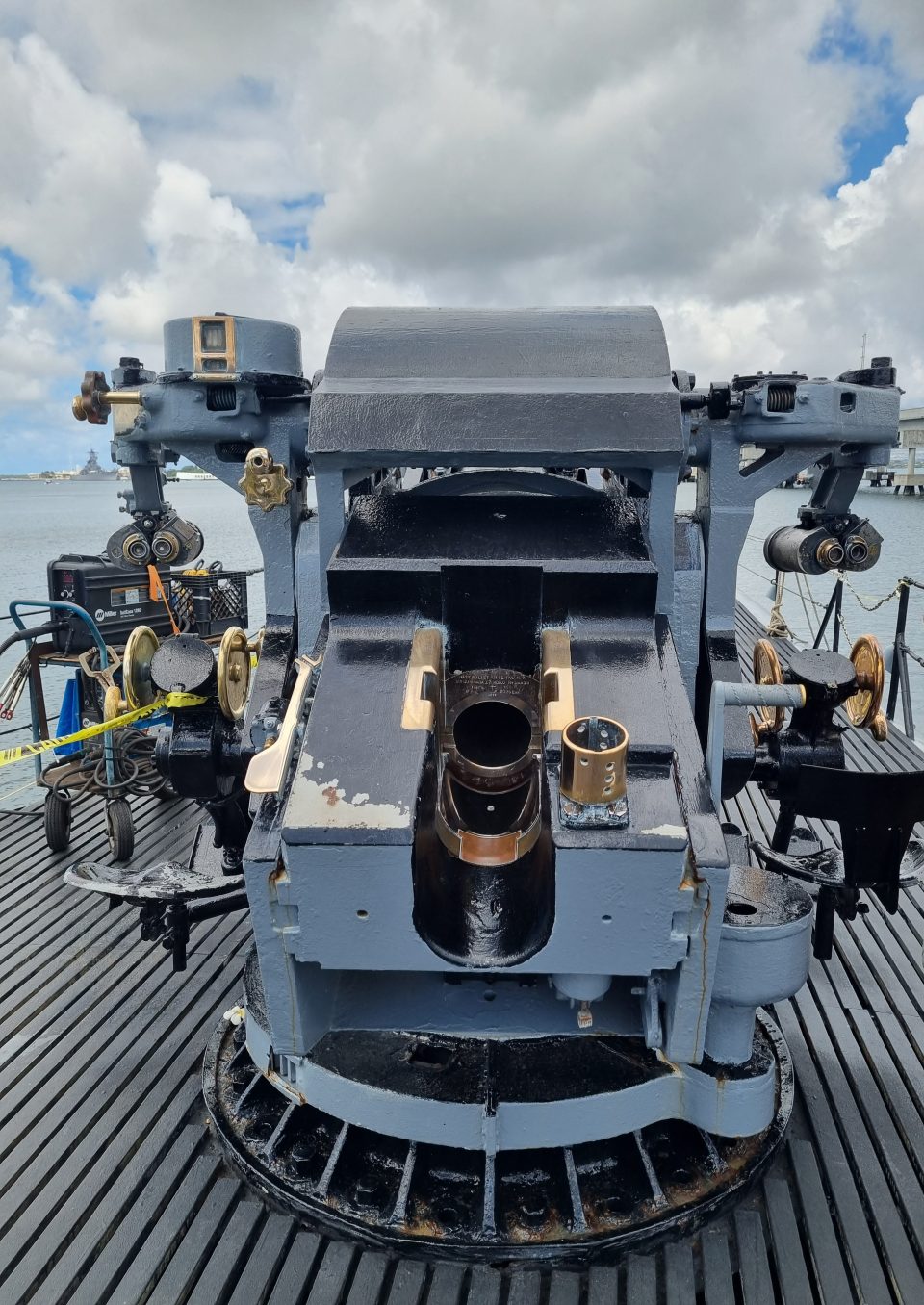
Hitler was sure that the U-boat war could not be won, if the Germans were not able to sink far more ships than the Allies could build. But this plan failed when by April 1943 the Allies were at last building replacements at a faster rate than the U-boats could destroy them. The reason was a revolution in shipbuilding in the USA, the Liberty ships. These were 9,000-ton all-purpose freighters, which were built at a rate of 140 per month. The new production lines were constructed on the principle of Henry Ford’s assembly lines and the Liberty ships were one of the industrial success stories of the US, just as Ford’s T-Model car. The entrepreneur Henry J. Kaiser, the son of a German shoemaker who had emigrated to the USA, had become one of the most powerful tycoons of the country, when the US entered the war. Among his many engineering projects, he had pioneered the construction of large merchant ships, which were built in sections and held together by welds rather than rivets. By this he could reduce the cost of production significantly and increase the turnout rate dramatically. The ships were designed to carry a wide range of goods from tanks to planes, iron ore and fresh food; they were basic models with no electricity or running water for the crew and passengers, the galley was lit by oil lamps and there was no fire detection system. A Liberty ship was supposed to have a very limited life expectancy only. Kaiser was ruthless and exploited his work force mercilessly. They were mostly destitute labourers from the “Dust Bowl States”, who were willing to work long hours for very low wages. The production lines were repeatedly streamlined and the workers were spurred on to ever greater efforts. Kaiser and his senior managers ran eighteen shipyards operating 24 hours. When one of the yards managed to finish a ship in twenty-three days, another yard was striving to finish one in ten days. The record was set in November 1942, when the SS Robert E. Peary was assembled in under five days. This was just PR, but the average time from start of production until the ship was launched was a surprising forty-five days. In this way a total of 2,700 Liberty ships were constructed until the end of the war. Kaiser’s workforce expanded from 4,000 to 80,000 at the beginning of 1943. In the end, Kaiser contributed to the Allied success of preventing Germany from winning the tonnage war in the Atlantic.
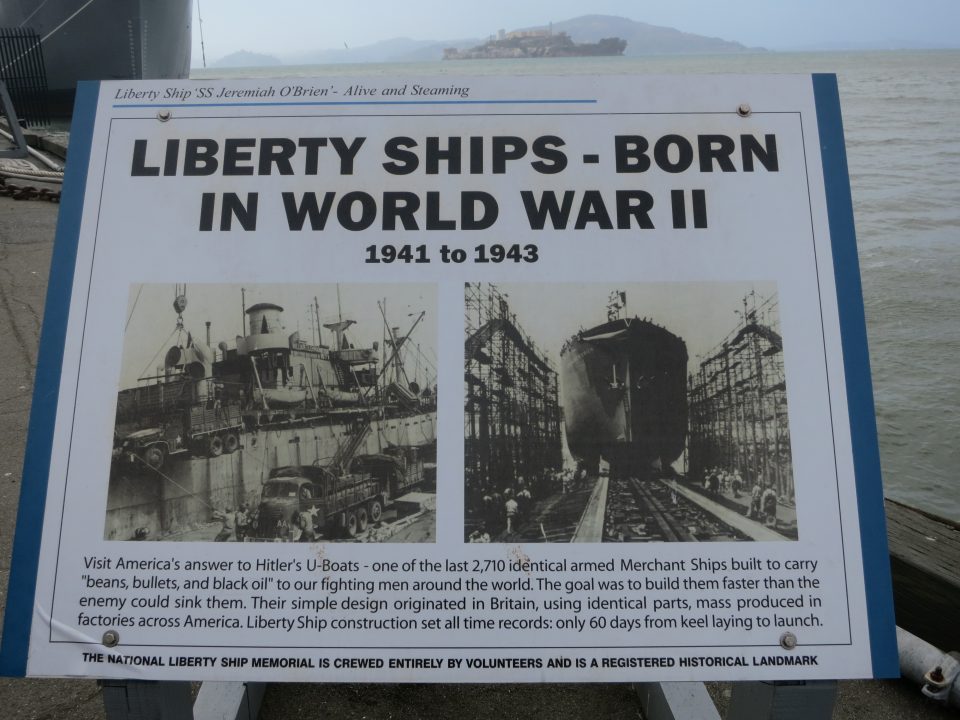
The effectiveness of the convoy system, once employed in the “Battle of the Atlantic”, can be seen, when comparing the figures before and after its proper introduction. Of the around 2,700 Allied and neutral merchant ships sunk by U-boats less than 30 percent were torpedoed in a convoy, 60 percent were unescorted and the remainder were stragglers from convoys. From 1939 until 1942 4,435 Allied and neutral ships were lost, while from 1943, when the Allied convoy system became fully operational, only 1,452 Allied and neutral ships were sunk. All in all, the “Battle of the Atlantic” was the longest continuous battle of World War II. So, at the start of 1944 the safety of Allied convoys across the Atlantic Ocean had improved so far that more civilians were allowed to board the freighters and liners and cross over to the Americas from Britain and vice versa, which made it possible for Käthe to join her husband in Bolivia. Most convoys in that direction left from Liverpool to Halifax (July 1941 until May 1945). They were called “ON convoys” – “Outbound from the British Isles to North America”. “UC convoys” ran from Liverpool to the Caribbean, later New York (February 1943 until June 1945).
As mentioned above, the destiny of Britain during World War II lay to a significant degree in the hands of the non-combatant merchant fleet. As an island nation Britain was more reliant on maritime imports than other countries. All of its oil, 54 per cent of iron ore, 93 per cent of lead and 95 per cent of zinc, all of it essential for the war machinery, was shipped in from abroad. But also 70 per cent of food stuff had to be imported including 91 per cent of butter, 70 per cent of cereals and fats, 50 per cent of meat and 80 per cent of fruit. So, the greatest threat to Britain’s resistance against Hitler was cutting off the Merchant Navy lifelines. Although it was in bad shape in 1938 it was still the world’s largest merchant marine with more than 192,000 personnel including 50,700 Chinese and Indian sailors. All merchant sailors were casual, non-military labour who laboured from contract to contract and were unpaid when on land. This resulted in the absurd situation that if a merchant sailor’s ship was sunk, the sailor who was so lucky as to survive, was unpaid from the day of the sinking. This had an enormous impact on those merchant sailors who stayed in service during the war because the Merchant Navy suffered terrible losses at the hands of German aircraft, mines, and submarines. From 3 September 1939, the sinking of the transatlantic passenger liner “Athenia” northwest of Ireland, until the end of that year, a total of 165 merchant ships had been downed. The year 1940 proved even more tragic for the merchant marine as the Germans conquered Western Europe with the Fall of France in June 1940 and could make use of the French Atlantic ports. Their U-boats could now sail directly into the British Atlantic Sea lanes. The number of merchant vessels destroyed by the wolf packs rose from 1,059 in 1940 to 1,299 in 1941. There was some temporary relief in the Atlantic when Hitler invaded the Soviet Union in June 1941, but a new front for the merchant marine was opened up, when in August 1941 Britain began to supply the Soviet Union via Arctic convoys to northern Russia. Those voyages were most dangerous and trying for the crews, not only due to German air and sea attacks, but also due to sub-zero conditions and rough weather north of the Arctic circle. A round trip comprised 2,500 miles in distance (4,000 km), whereby on average one out of 20 ships did not survive.
Eventually in May 1941 the British government organised all merchant seamen into the “Merchant Navy Reserve Pool”, which additionally included 60,000 ex-mariners. They all had to put their names onto the register and the government would assign their manpower to whichever vessel needed it. They were obliged to be in service for the duration of the war, but the benefit for the merchant sailors was that they received a wage for the entire time of the war, even as prisoners-of-war, including a two-days’ paid holiday for each month served. At the start of the war the sinking of merchant vessels by far exceeded the numbers of ships built despite increasing contributions of Commonwealth allies, particularly Canada. Only the vast and expanding industrial resources of the United States, which joined in the war effort in December 1941, made the difference, especially the US Emergency Shipbuilding Program, which had already been started in January 1941 with the fast output of “Liberty” ships. Additionally, between 1944 and the end of the war 531 faster and more modern “Victory” ships were built. Escort duties were now performed by the Royal Navy, Commonwealth fleets and the US Marine. A convoy initially numbered 30 to 40 ships, accompanied by just one or two warships, typically aging destroyers, frigates, or corvettes. Later the merchant ships themselves were equipped with basic armament, such as anti-aircraft machine guns, automatic cannons and various surplus low-angle and high-angle guns under the DEMS programme (Defensively Equipped Merchant Ships). Mostly the guns were manned by soldiers, but around 150,000 merchant sailors were also trained in gun support and operation. A major step forward was the Lend-Lease Programme, in which the US lent its Allies military material, such as warships, in return for no-cost leases on army and naval bases in Allied territory, e.g. Northern Ireland, Iceland and Greenland. In September 1940 Britain received some 50 rather obsolete destroyers via this programme, for example. New anti-submarine weapons, such as the “Hedgehog” A/S mortar, the detection system ASDIC, the High Frequency Radio Detection Finder “Huff-Duff”, and the centimetric radar made life safer for the merchant seamen.
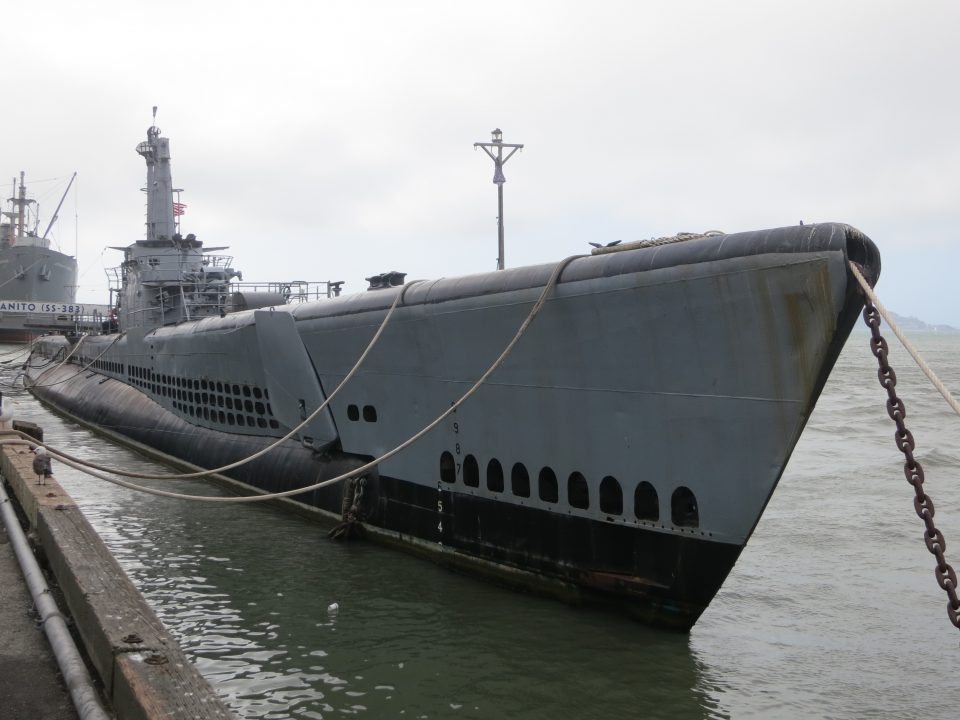
In the same way the US Merchant Marine had suffered under a lack of investment in merchant shipbuilding and renovation before the war, which meant that its 1,340 pre-war vessels were often aging or obsolete. In 1940 the total manpower was just 55,000 sailors, approximately the number of foreign sailors in the British Merchant Navy. Due to the growing involvement of the US in the war, the US government invested more in the training of officers and service men in the Merchant Marine and created a large body of men to serve in the US Navy Armed Guard, which provided the gunners, signalmen and radio operators, who assisted in the merchant ship defence. By the end of the war the US Merchant Marine had grown to 4,221 vessels and 255,000 trained service men, the world’s largest in 1945.
In a convoy the strongest element were the merchant vessels, which constituted the largest number of ships and most of the personnel. The British Merchant Navy was hard hit by the economic collapse of 1929 and the economic crisis years of the 1930s. The officers were usually from families with a maritime tradition and were well-trained. The rest of the personnel could be divided into three groups: seamen, machinists, cooks, and stewards. Most of the British sailors came from harbour cities such as London, Liverpool, Cardiff, Glasgow, Hull, and Southampton. Many of the shipping companies which traded in Africa, India and east Asia hired sailors from these regions. They amounted to 50,000 out of 190,000 seamen overall in the British merchant navy. East-Indian sailors, especially those from Bombay, Sikhs from the Punjab, and Chinese from Hongkong or mainland China were the most experienced and appreciated seamen. The best stewards were considered those from Goa. Africans were mostly employed in the machine rooms. All in all, the seamen saw little of the huge profits the British shipping companies made. Mostly the sailors took on work on the next ship as soon as they arrived in a harbour in order not to forego payment because they were not entitled to holiday pay and if they were not under contract of a shipping company for a voyage, they earned nothing. This resulted in the fact that especially poorer sailors never saw land, but jumped from one ship to the next. With the outbreak of World War II demand was high and every vessel, no matter in which state of repair, was used for transporting vital goods to Britain, which was under attack of the Nazis. This meant that a new type of sailor was hired, namely young men who would rather serve in the merchant navy than in combat troops. Now every merchant ship had to have three trained radio operators on board and at least one heavy cannon and some light weapons. At the beginning reservist gunners manned the cannons, but later the Royal artillery trained special “sea regiment” units for this purpose. All the seamen in the “Merchant Navy Pool” had the right to reject twice a ship they were offered, but the third proposal had to be accepted. So, a sailor had to think twice before rejecting the second option because the third one could be a scrap-metal small fishing trawler, but it could as well be an elegant liner, such as the “Queen Mary”. The voyage they then undertook could last a month, but could also last a year and usually the sailor did not know anyone on board the ship. The most dreaded route was the Arctic convoy, whereas the Atlantic convoys were preferred despite the ever-present threat of being torpedoed and sunk, because it was the shorter roundtrip and usually there was time to spend on land in Canada or the USA. When landing again in England the sailor received his remaining pay and was allowed to take 11.25 kg of rationed food stuff on land. Furthermore, the sailor could enjoy a paid holiday before boarding the next ship. Although sailing on a merchant vessel was considered a civilian job in Britain during the war, it was a most dangerous one: a quarter of the merchant seamen died at sea; their mortality rate was higher than overall in combat troops. Luck played an important role; some seamen were never attacked by the enemy, others survived three or more attacks.
The conditions under which the sailors worked in the US merchant marine were similar: abysmal working conditions, nasty food, low-wage competition, and insecure labour contracts. Most of the US sailors came from the great harbours New York and Baltimore, Philadelphia, Boston, New Orleans on the East Coast; the West Coast was served from San Francisco. Even before the USA joined the war, business was booming. More young man enlisted because the pay on a merchant vessel had become much better and a bonus was paid if the ship entered a war zone. The war turned out to be a huge success story for the US shipping industry, but it became difficult to find enough trained merchant sailors to man the many ships the industry turned out. After a year on board a sailor could start his training as an officer and participate in a correspondence course to gain his officer’s commission. In this way “assembly lines” did not only turn out large numbers of vessels, but also merchant seamen. Every US merchant vessel had several gunners from the “Armed Guard” on board. The British seamen were envious of the American merchant sailors because of their higher pay and they despised them for their lack of training. In the second half of the war most merchant ships in a convoy were British and American ships, but also vessels from Allies and from some neutral countries sailed under escort.
The tragic culmination of the tonnage war in the “Battle of the Atlantic” in March 1943 was the attack on convoys HX.229 and SC.122, which cost the Allies 22 merchant vessels with 146,596 tonnage: 16 freighters, 5 refrigerator ships and one tanker, 10 of them British, 6 American, 3 Dutch and one from Norway, Greece, and Panama each. When these ships were torpedoed, they had 1,494 crew and passengers on board. Of these 360 crew members and twelve passengers died, among them two women and two children. The dead came from more than twenty countries, most of them from the USA. The Germans only lost one boat of the type VII C U384 and 47 crew members. The lack of Allied escort vessels and the non-existent air cover caused this catastrophe. During the first twenty days of March 1943 the Germans sank 97 Allied merchant vessels of 500,00 tonnage, two thirds of them sailing in convoys, while the Germans only lost seven U-boats. To sum up, 5,150 Allied merchant vessels were lost during the war and the Germans sank 148 Allied war ships and approximately 50,000 merchant seamen lost their lives, two thirds due to U-boat attacks.
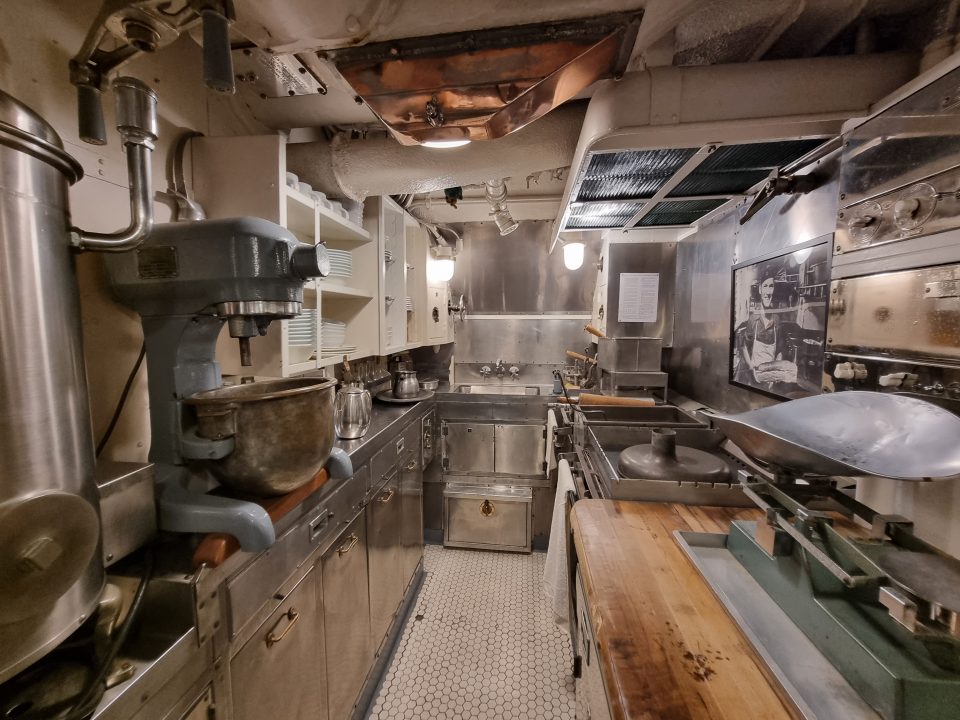
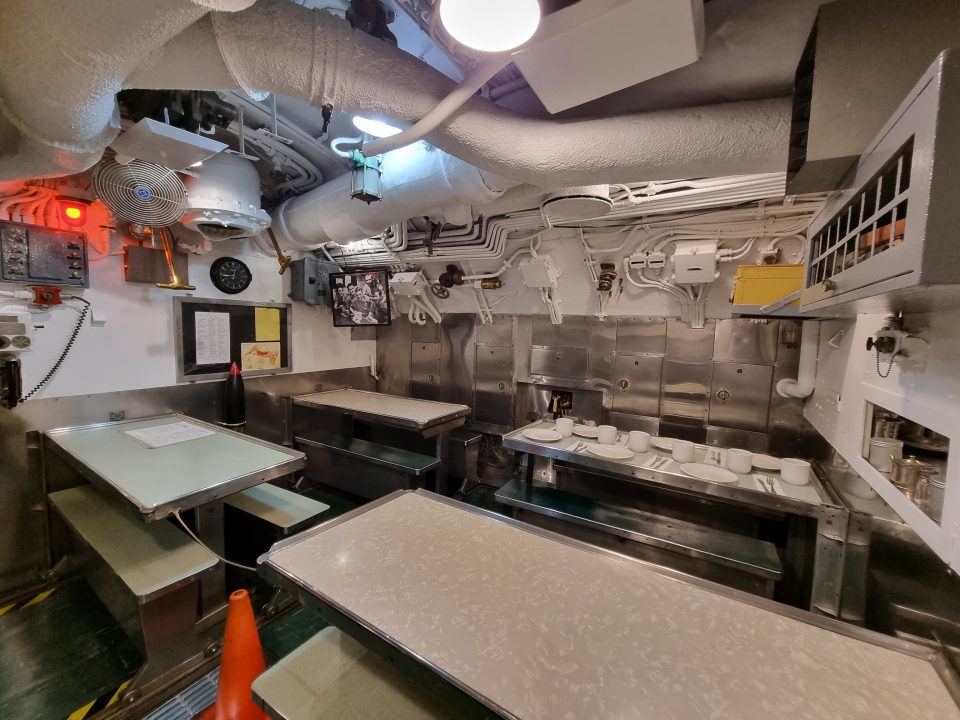
Merchant ships, their sailors and their passengers faced countless daily threats on their journeys, such as mines, air and U-boat attacks, surface raiders and the dangers of the sea as well, from mountainous Atlantic storms to falls overboard. In a convoy if someone fell overboard and the convoy did not have a destroyer escort present, the convoy ships were forbidden to turn around to rescue the person. The peak of merchant ship destruction was reached in 1942 with 1,662 vessels sunk largely as a result of the wolf packs. Despite all these dangers, by the end of 1943 until the end of the war, passages on merchant ships became progressively safer. The Allies steadily gained air supremacy and the combination of new detection technologies and new weapons reduced the danger of U-boat attacks. Improved escort tactics and the loss of the French Atlantic ports after the Allied landing in Normandy in June 1944 meant that much fewer merchant vessels were lost. Unfortunately, over the whole war, the cost of lives in the Royal Merchant Marine was much higher than in most combat forces, although accurate figures are difficult to come by. Around a quarter of all merchant navy personnel who served in World War II died; 36,749 men and women. The casualty rate is only exceeded by the RAF Bomber Command. The US Merchant Marine suffered heavy losses, too; the numbers can only be estimated between 6,000 and 9,000, but they were not as severe as the British ones.
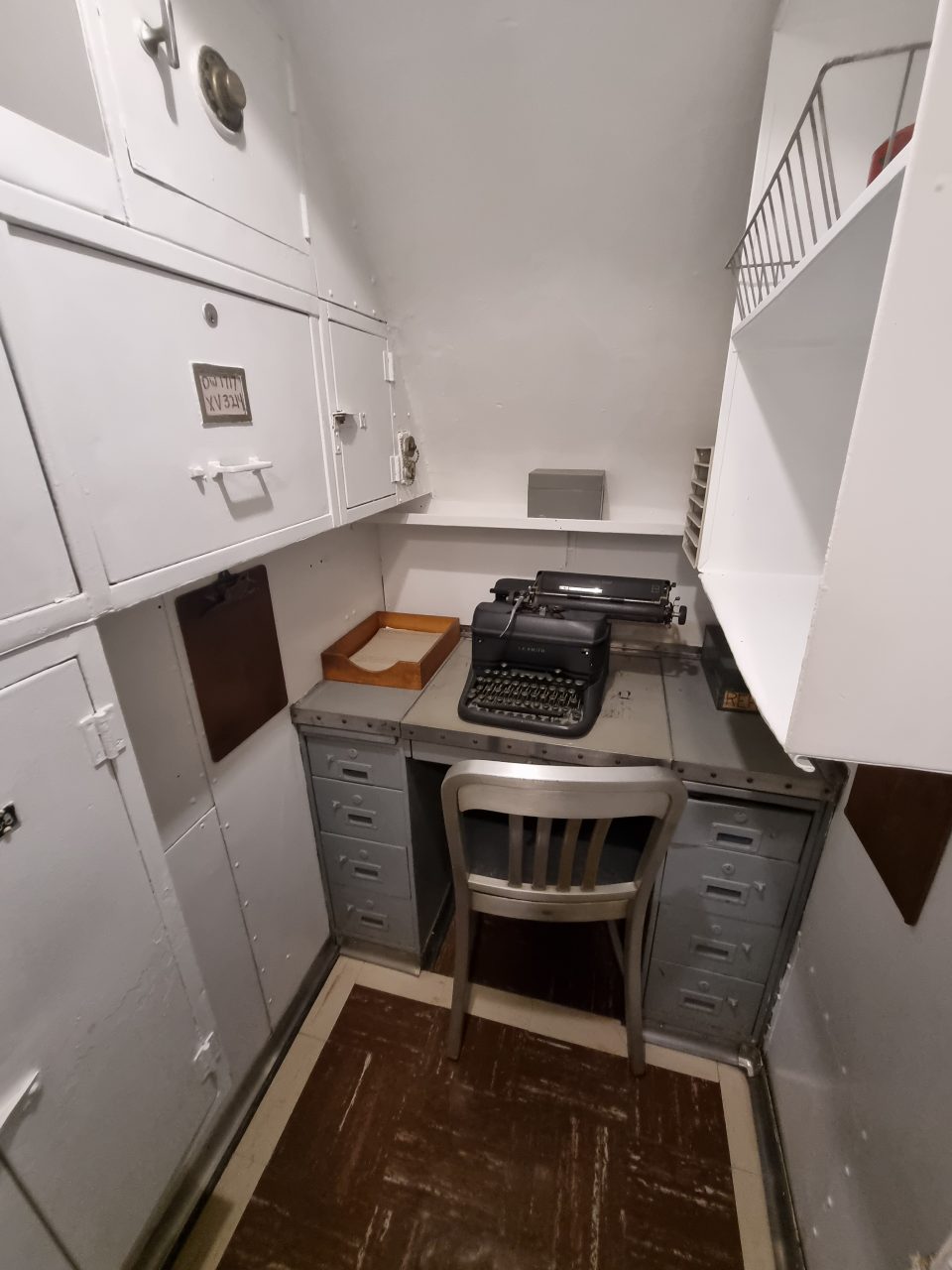
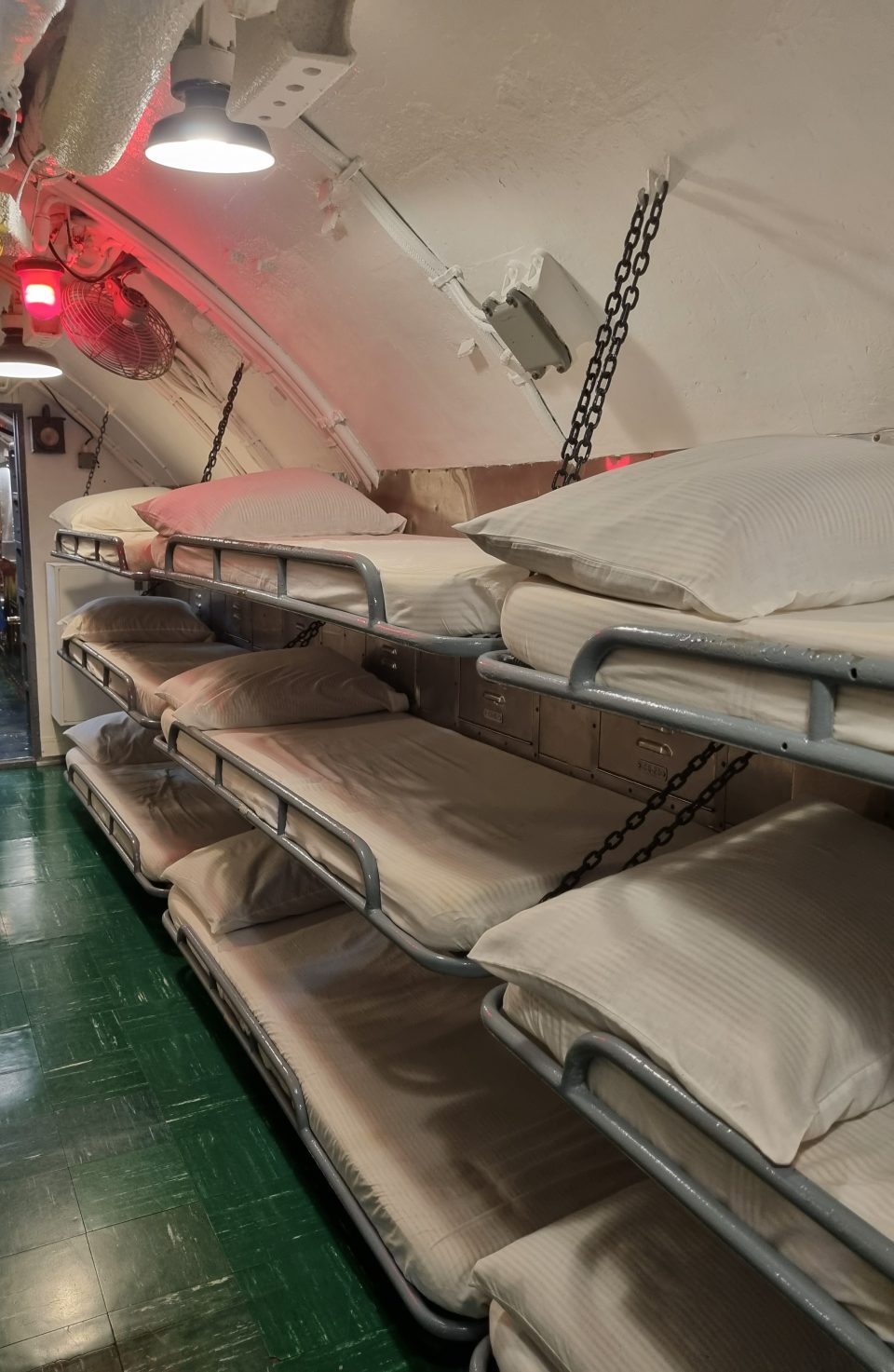
”The Merchant Seamen. Pocket Manual”, 1939-1945, provided the crew on merchant ships, which sailed individually or in convoy, with a brief and comprehensible guidebook during wartime. The chapter on safety and survival was of greatest importance because it focused on how to prepare for and survive an emergency at sea. It listed the “Merchant Marine 10 Commandments”: “1. Fight the ship through. Your responsibility – your best bet. 2. Make sure all emergency gear is ok. Know how to use it. 3. Drill until action is automatic. 4. Take the lead if necessary. Get your bearings plan then act. 5. Keep physically fit. 6. Be expert at first aid. 7. Know how to swim. 8. Learn how to help survivors. 9. Know how to live if castaway. 10. Understand your fears and anger. Learn how to handle them.”
In this chapter there are paragraphs on how to stay healthy and fit on board, to learn the whistle signals and memorise the position of the ship each day, how to keep your head in action, instructions on the upkeep, equipment, and use of lifeboats, checking on water and provisions and the need for continuous drill so that every action becomes automatic. Furthermore, there are precise guidelines on how to behave if you must get off the ship on your own, about suction and how to swim in oil if a tanker is sunk and finally how to abandon ship. Crew members and passengers would have to undergo these safety drills on a regular basis during a voyage crossing the Atlantic in a convoy. Käthe had to take part in all these drills on her convoy passage from England to Argentina. When she finally arrived in Bolivia on 2 April 1944, she moved in with her husband Karl in Sucre and joined in the shirt-making business of Karl, Mitzi and Bill.

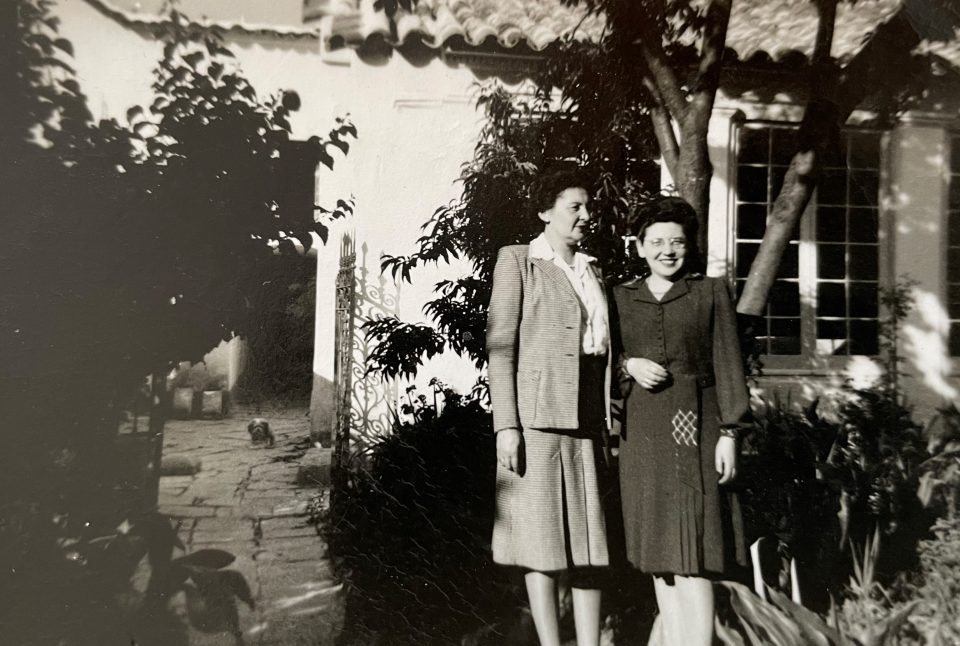

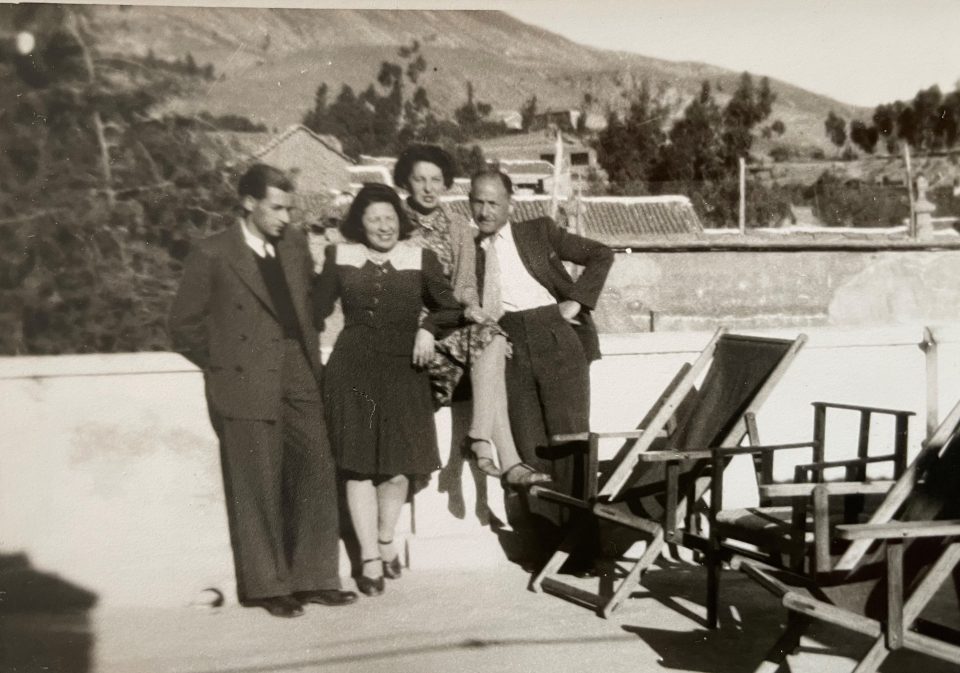
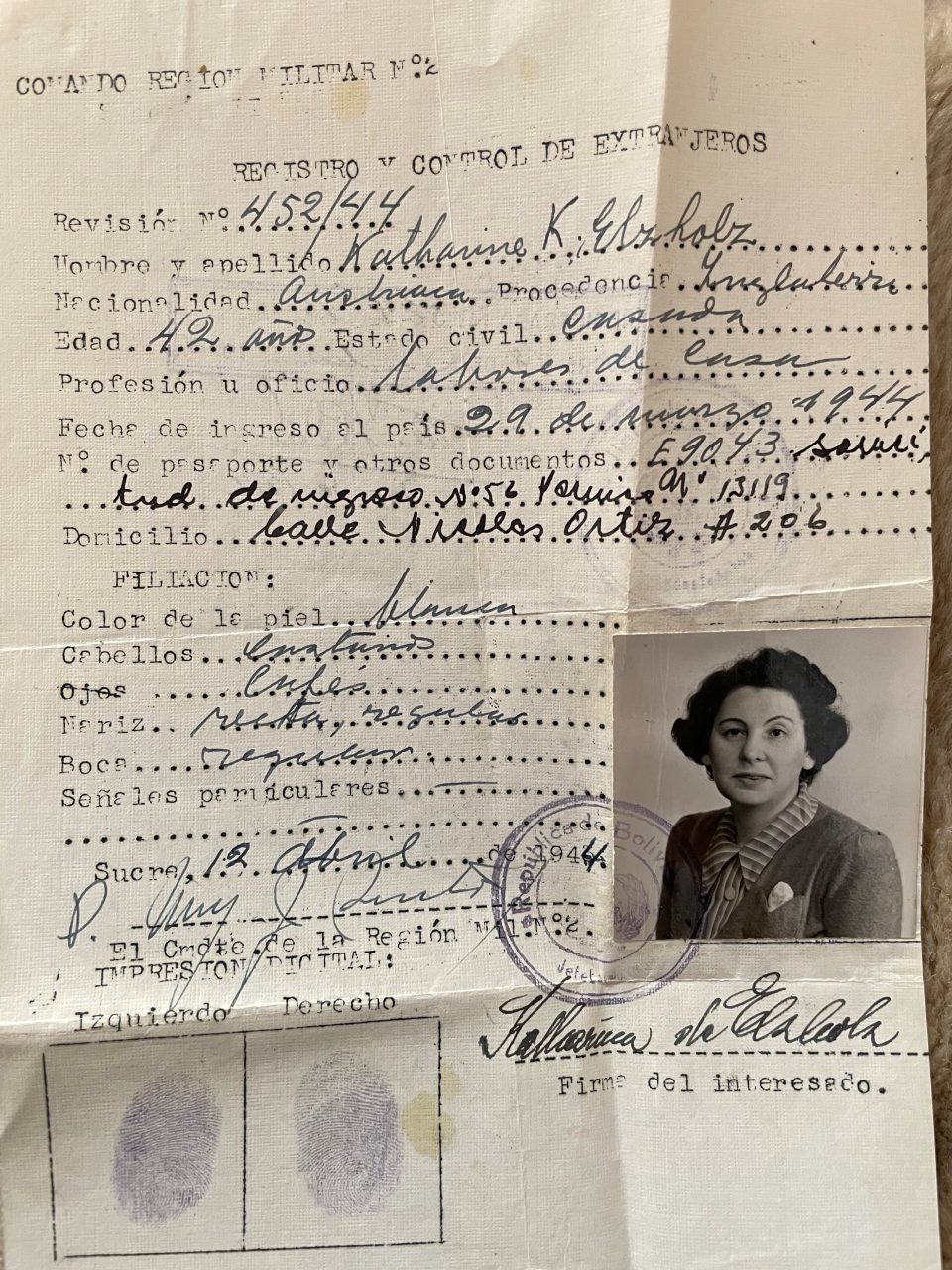

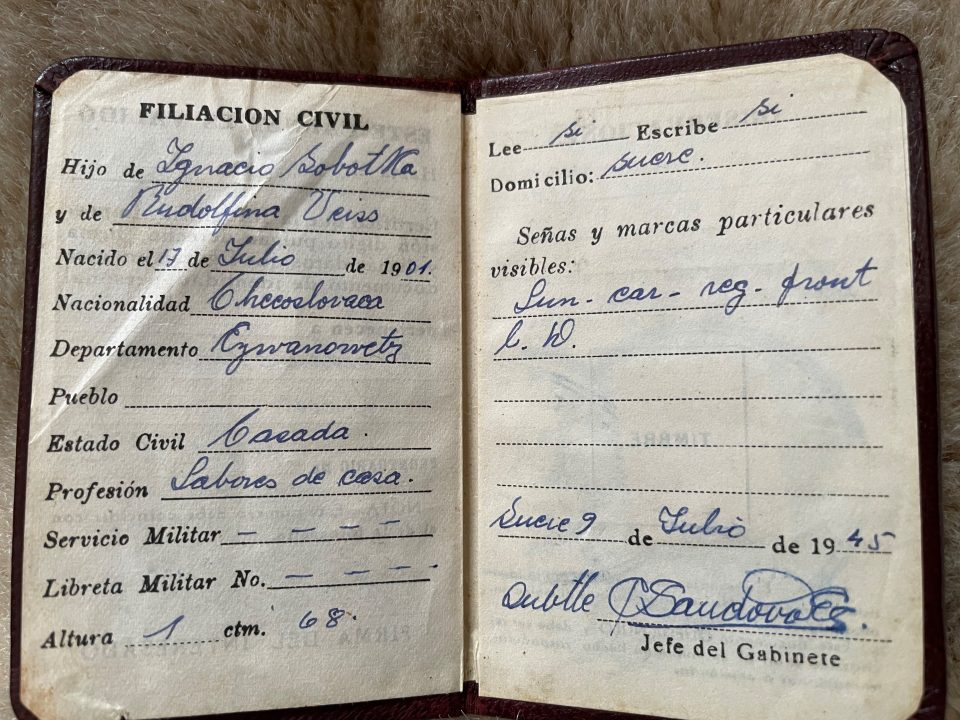
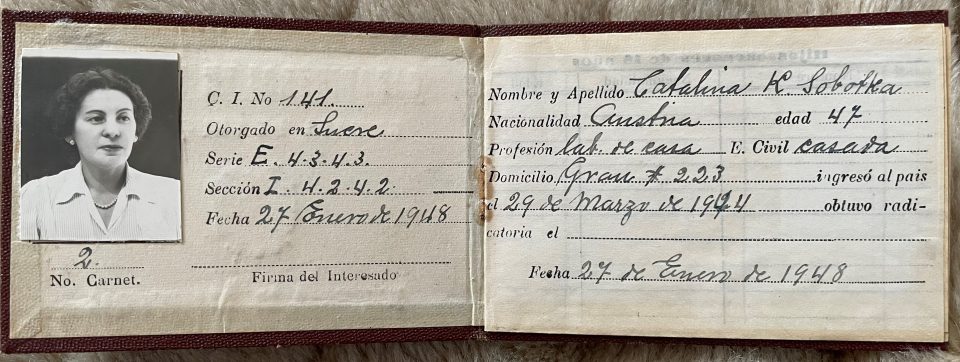
A little more than four years after her arrival, in July 1948 Käthe together with Karl left Bolivia and crossed the Atlantic Ocean once more to eventually return to war-ravaged Vienna. They took the steam ship “Ravello” of the company “Archille Lauro” from Buenos Aires in Argentina to Genova in Italy:

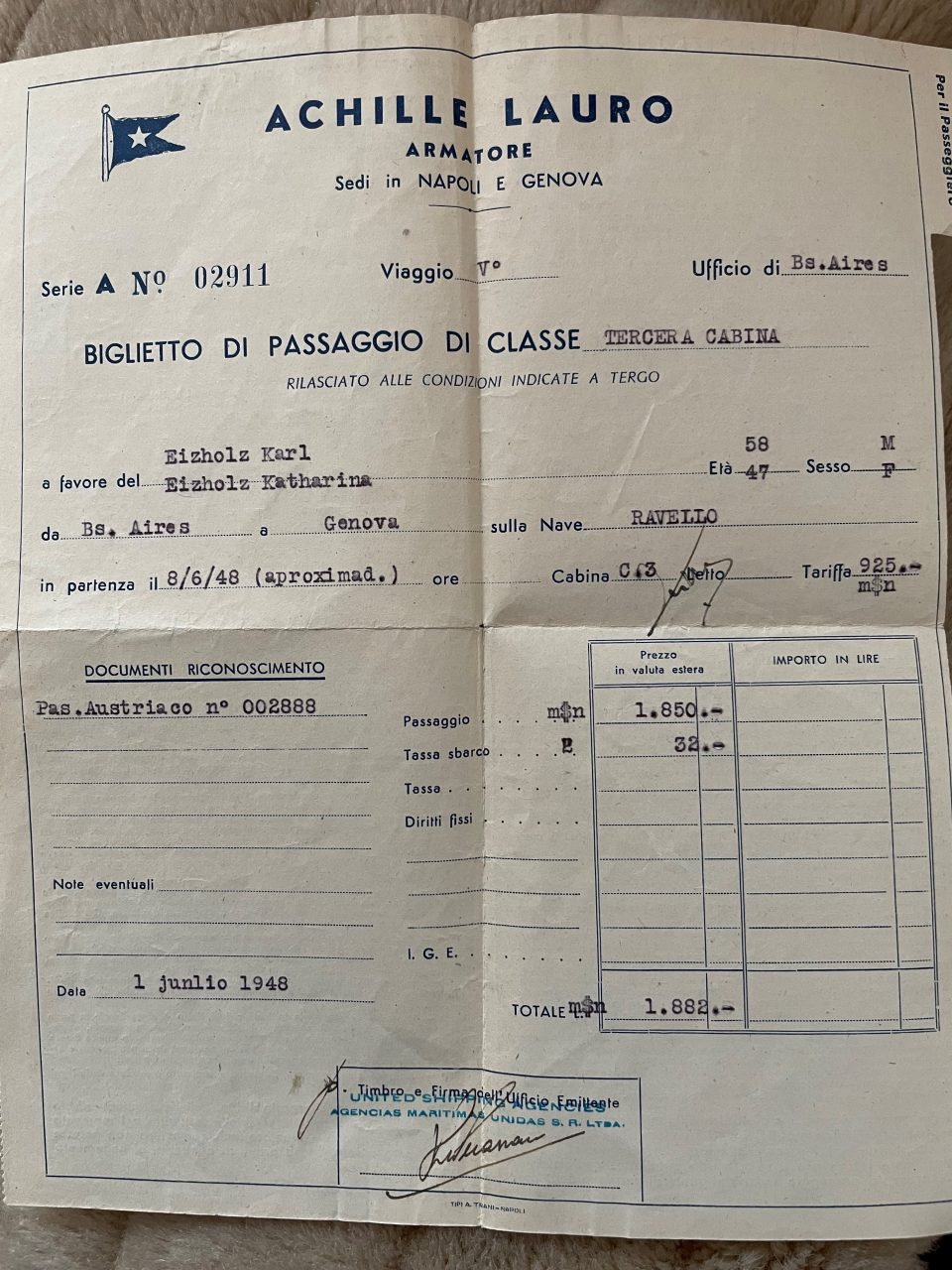
Käthe kept a brief diary of this voyage home:
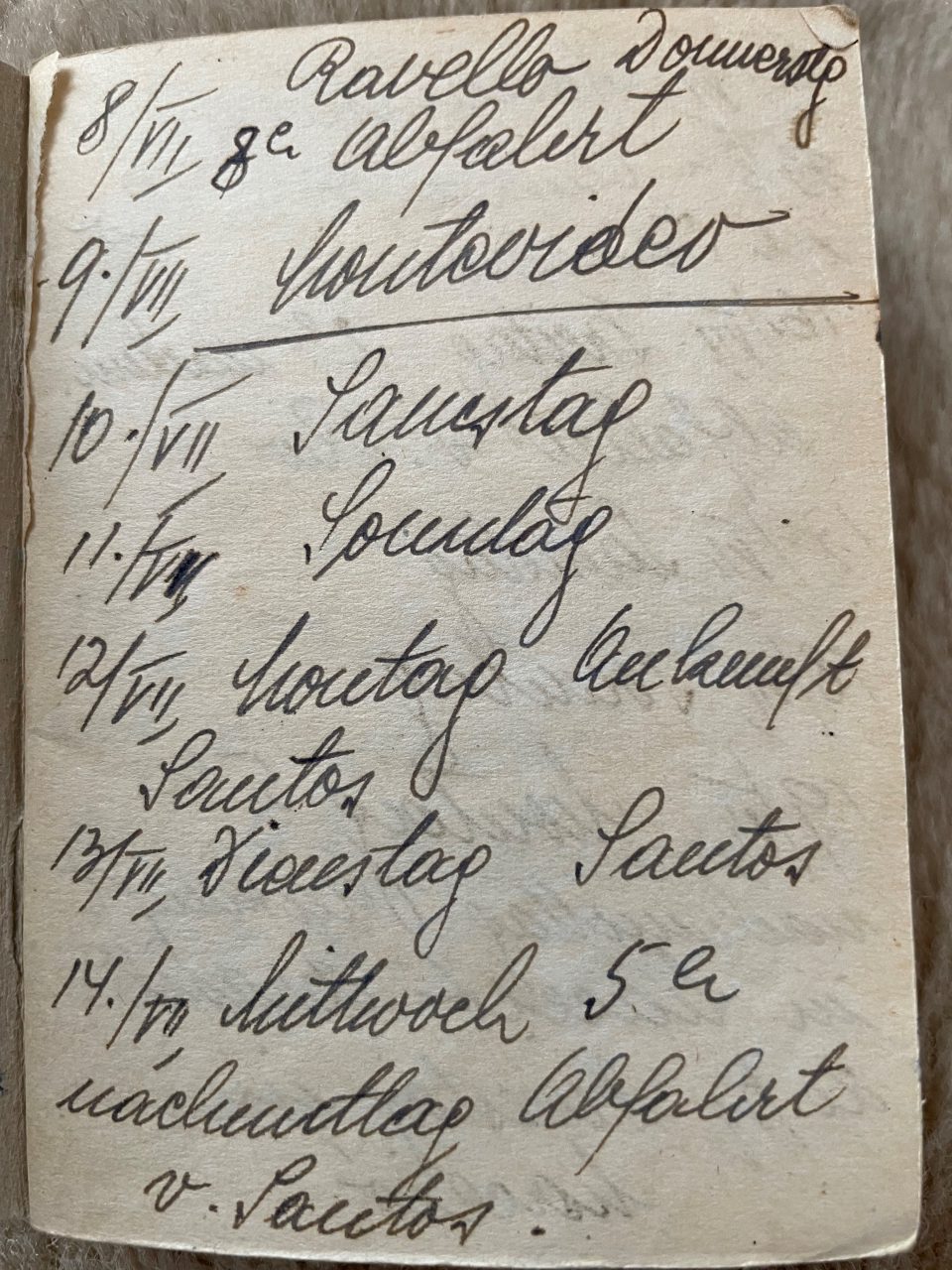
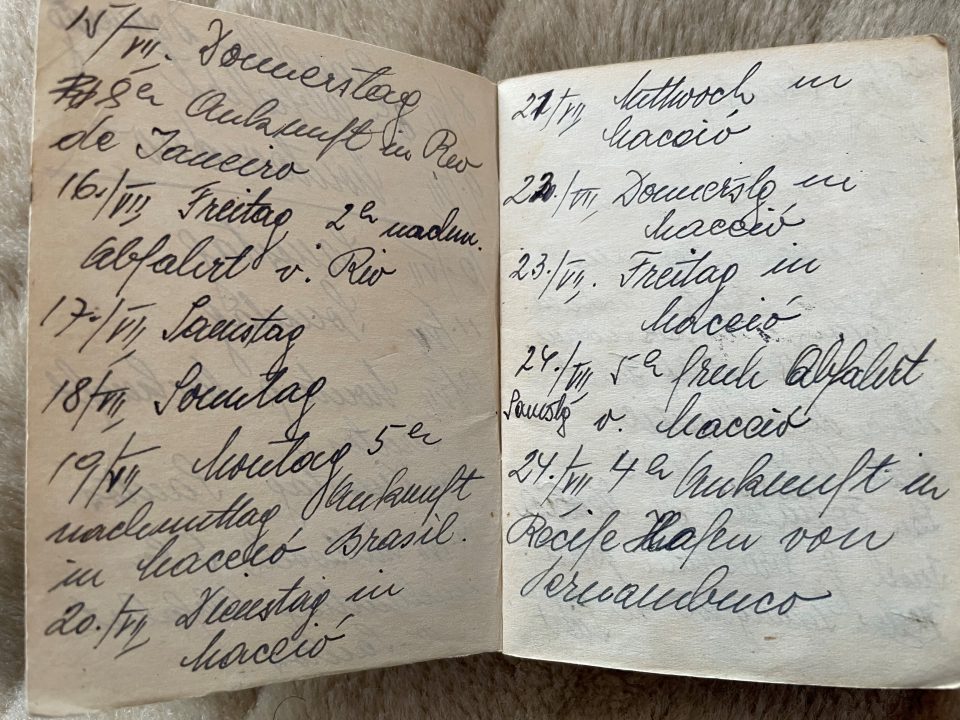
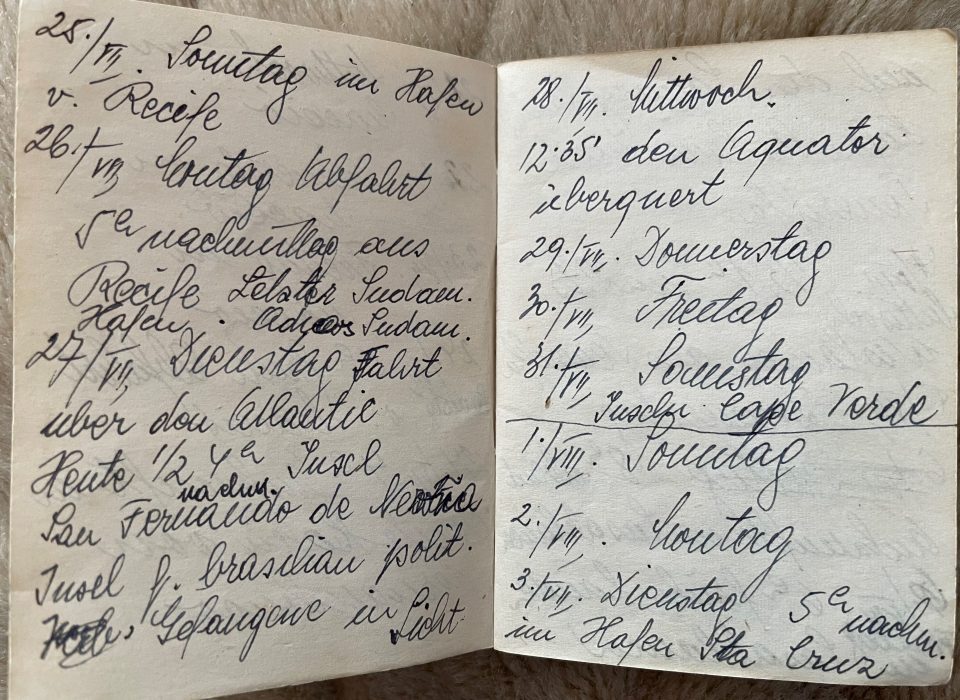
On Thursday 8 July 1948 they left Buenos Aires on the boat “Ravello” at 8 am. Via Santos, Rio de Janeiro, Maceió Brasil and Récife, the last harbour in South America, they then started the crossing of the Atlantic Ocean on 27 July. They passed the island of San Fernando de Noronha, an island where Brazilian political prisoners were held, as Käthe noted. On 28 July at 12.35 they crossed the equator and on 31 July they arrived at the Cap Verde islands. On 3 August at 5 in the afternoon they entered the harbour of Santa Cruz on Teneriffa, Canary Islands. On 5 August they arrived in Casablanca at 8 pm and on 8 August at 9 am their ship passed Gibraltar.
On 11 August they entered the harbour of Naples, where they did some sightseeing; Capri, Pompeii, and Naples, then passing the islands of Monte Cristo, Corsica, and Elba, they headed towards Genova. On Monday 16 August 1948 they arrived in Genova at 9 am. In the evening they took the train to Venice, where they arrived on Tuesday 17 August at 9 am. Then they boarded the train to Austria at 3 pm. They arrived at Tarvis, the border to Austria, at 9 pm and after an hour’s wait at the frontier, they finally arrived back home on the Austrian side of the border, as Käthe noted in her travel diary.

In Vienna the four “Sobotka sisters” – Käthe, Lola, Agi and Mitzi – were reunited with their families for brief visits, when Agi, Norbert and the twins came from London and Mitzi and Bill arrived from the US to see those of the family who had remained in Vienna, namely Lola and Toni (my grandparents) with Herta (my mother), those who had returned to Vienna for good in 1948, Käthe and Karl, and the four Sobotka sisters’ parents, Ignaz and Ritschi Sobotka (my great-grandparents), who had been liberated from the concentration camp KZ Theresienstadt in 1945.
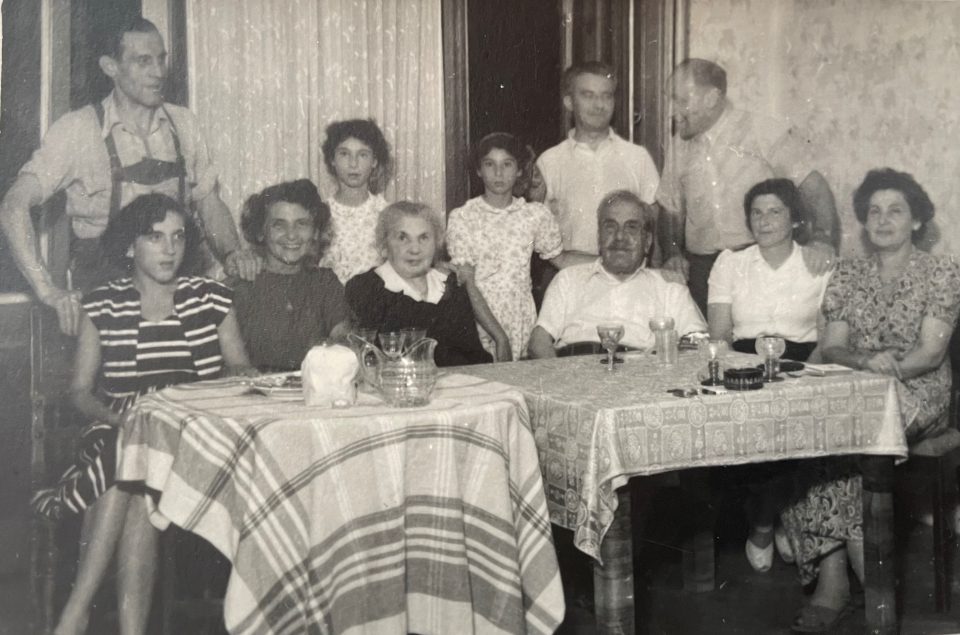
Standing left to right: Toni (my grandfather), the twins Susi and Josi, Norbert, Karl

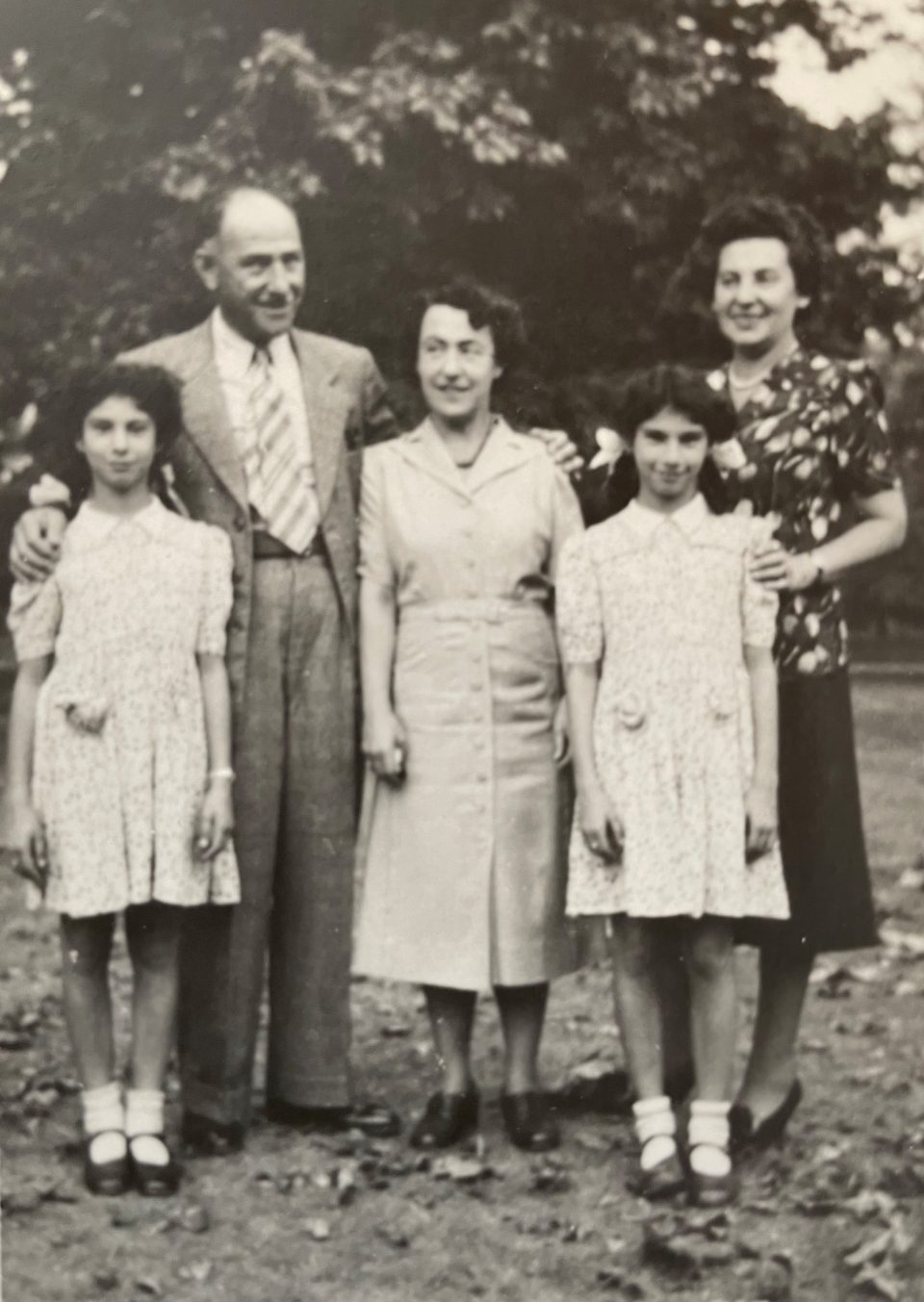
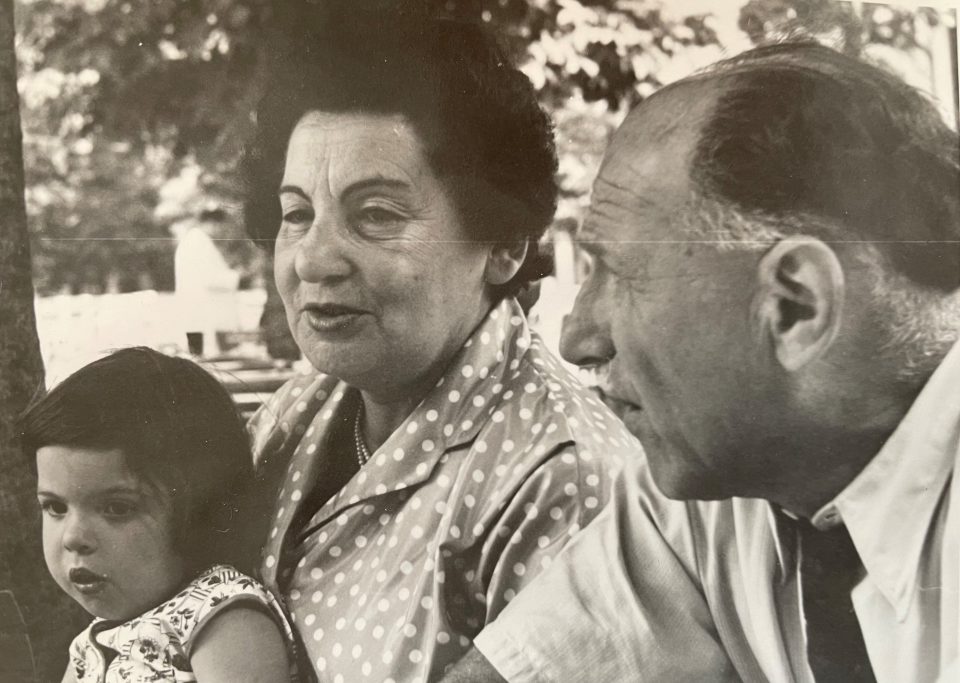
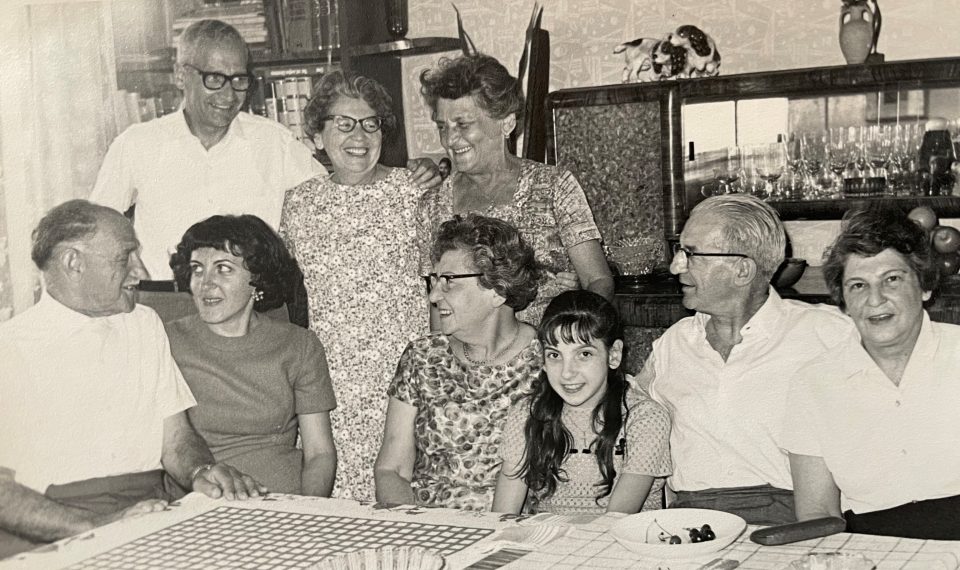
Standing: Bill, Mitzi and Lola
LITERATURE:
Cross, Robert F., SHEPHERDS OF THE SEA: DESTROYER ESCORTS IN WORLD WAR II, 2013
Dimbleby, Jonathan, THE BATTLE OF THE ATLANTIC. HOW THE ALLIES WON THE WAR, Viking 2015
Middlebrook, Martin, KONVOI. U-BOOT-JAGD AUF DIE GELEITZÜGE SC.122 und HX.229 (1943), Ullstein 1995
McNab, Chris, THE MERCHANT NAVY SEAMAN. POCKET MANUAL 1939-1945, Casemate Publisher 2018
